


















Publishers:
Gurvinder S. Hundal
Ramneek S. Dhillon
Graphic Designer: Jaskaran Singh
Editor:
Ancy Mendonza
Contributing Writers:
Gurleen Kaur Bajwa
Mrinalini Sundar
Naina Grewal
Natasha D'souza
Ancy Mendonza
Shweta Kulkarni
Cover Credits:
Hair & Makeup: Harry Rajput
Photography: Harry Rajput
Advertising & Sales:
Gurvinder S. Hundal
Ramneek S. Dhillon
Prapti Taneja
Darpan Diwali Issue is Published By:
Darpan Publication Ltd.
Darpan Diwali Magazine is published annually. Any reproduction of this magazine, editorial content, images or advertisement cannot be reproduced or reprinted in any form, without prior written permission of the publisher. The views expressed by the writers in this publication are not necessarily the views of the publishers. The publishers assume no responsibility for errors or omissions.
Copyright 2024, Darpan Publications Ltd.
All rights reserved. Publications sales agreement no. 4116014.
POSTMASTER IF








By Naina Grewal



or many, celebrating Diwali away from their homeland is a mixture of nostalgia, adaptation, and a heartfelt attempt to recreate the warmth of the festival in a new setting. The essence of Diwali—sharing joy, lighting up homes, and being with loved ones—stays constant, but circumstances surrounding the celebrations evolve with time and distance. For those who have recently made Canada their new home, Diwali serves as a bridge to their roots, even as they navigate unfamiliar
traditions and surroundings, reflecting the universal yearning to maintain cultural connections amidst seizing new opportunities around the world.
Sarandeep Kaur, who moved to Canada earlier this year, finds comfort in
maintaining her family's traditions even while far from home. “Celebrating with family is the same for us here as in India,” she highlights. Similarly, Veena Rani Heer, who moved to Canada this year, has been determined to celebrate a Diwali much like
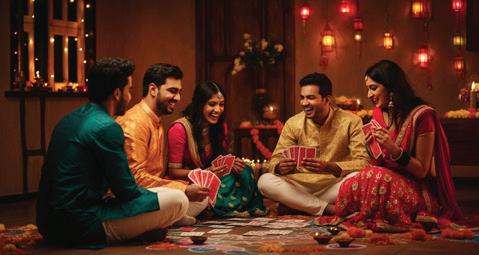



the ones she remembers so fondly, detailing, “We will share sweets with those we know. I will be decorating my home, lighting up clay lamps, and cleaning my house as per tradition.”
Also having recently immigrated to Canada, Gauri Mahajan reflects on how she recreates the spirit of the festival, “Diwali has always been a very special time for my family and me. Back home, we would always gather together, and my friends would join in, too. Typically, we would decorate our homes, cook, and enjoy meals together. To bring that same feeling to my first Diwali in Canada last year, I invited my friends over, we decorated my place, and I cooked for everyone. We dressed up as well since we don’t get the chance as often.”
For Dr. Shivali Aggarwal Gill, the transition to celebrating Diwali in Canada has been bittersweet. “I definitely enjoyed Diwali more in India,” she reflects, noting how the presence of close friends and family back home made the celebrations more vibrant. “The feeling of sadness is amplified when I see people enjoying the festivities on social media, the same people I used to celebrate with,” she adds,



"Dr. Shivani Aggarwal Gill
highlighting the challenge many immigrants face of being connected yet distant through technology.
Last year’s Diwali, her first in Canada, was a solo affair for Dr. Aggarwal Gill, as she shares, “Last year, I was working, and after work, I was so tired that I didn’t even have enough energy to partake in Overall, I can say that it will take some time to adjust to Diwali in Canada, but Diwali in India will always hold a special place in my heart.”
any events.” This year, she is a student at a university that is organizing and hosting Diwali celebrations, “I am excited and also considering participating in events by offering mehndi (henna) and make-up for others. This will not only help me connect with the community but will also help me get in touch with potential clients for makeup services that I offer. Overall, I can say that it will take some time to adjust to Diwali in Canada, but Diwali in India will always hold a special place in my heart.”
The insights of Tushar Sharma, Saif Khan, Jai Sharma, and Alakh Singh Sandhu reflect how Diwali can become a source of unity among those far from home. The four friends, each of whom recently moved to Canada, found themselves celebrating Diwali together last year, finding comfort in each other’s company amid the absence of their families.
“Festivities, often centered around happiness, feel glum for those who live away from family,” they express, capturing the melancholy that comes with celebrating without the familiar faces of home. Yet, they also found a sense of solidarity in their shared experience. “Staying away


from home, it felt like a flame was kept alive in our hearts, meeting three fellow strangers in a foreign land, with nothing in common but a bond of brotherly affection,” they describe, showcasing how their initial isolation transformed into a sense of brotherhood.
Their Diwali was an amalgamation of traditions, with the friends coming together to perform rituals like Vishwakarma Puja and Kuber Puja, despite coming from different faiths. They note, “All of us came from different faiths by birth, yet humanity became our only religion. As we held our firesticks pointed toward a mutual junction, all we could do was smile at a hopeful tomorrow, laugh at a glorious present, and reflect on how the blood of the covenant is often thicker
"Staying away from home, it felt like a flame kept alive in our hearts, meeting three fellow strangers in a foreign land, with nothing in common but a bond of brotherly affection.”
Tushar Sharma, Saif Khan, Jai Sharma & Alakh Singh Sandhu
than the water of the womb."
Undoubtedly, exchanging laughs and memories that bridge the distance to families back home and shared cultural adaptation can lead to unexpected bonds and a shared sense of home, even when one is far from where one started. While the setting may change from the bustling streets of India to quieter neighborhoods in Canada, the festival’s spirit remains intact. For those celebrating their first Diwali
far from home, it’s a time to find new ways to connect as immigrants weave their heritage into the fabric of their new home, ensuring that the light of Diwali shines brightly, no matter where we are.




"Diwali holds a lot of meaning for me; it is a special time of the year, and I always look forward to spending it with my family. Our annual ritual includes thoroughly cleaning our home to clear out the clutter, donating items we no longer use, and feeding the less privileged and this year will be no different."

By Shweta Kulkarni


If there is one word that captures the essence of actress Richa Chadha, it is audacious! Whether it is the fearless roles she takes on or the bold opinions she shares on social issues, Richa is a force to be reckoned with—both on-screen and off-screen.
In an industry often defined by formulas, Richa is one of those rare breeds of actors who thrives in both indie gems and mainstream entertainers, dazzling audiences with her remarkable versatility. From the sharp-tongued Nagma Khatoon in Gangs of Wasseypur and the unapologetic Bholi Punjaban in Fukrey to the heart-wrenching Devi in Masaan and the lovestruck courtesan Lajjo in Heeramand i, Richa’s powerpacked performances not only showcase her range, but they set the bar higher every time, leaving the audiences craving for more.

In a true multifaceted style, Richa is currently juggling an impressive lineup of roles—not only as an actress but also as a producer, wife, mother, and doting pet parent. Amid her packed schedule, we caught up with this feisty actress in a candid moment—midway
between rushing a sick dog to the vet and prepping for her daughter’s first Diwali celebration—to chat about her journey in Bollywood, her newly embraced role as a mother, festive plans, and her take on why a firecracker-free Diwali is the best kind of Diwali!

As Diwali approaches, how do you plan to celebrate the festival? Do you follow any specific traditions or rituals each year?
Diwali holds a lot of meaning for me; it is a special time of the year, and I always look forward to spending it with my family. Our annual ritual includes thoroughly cleaning our home to clear out the clutter, donating items we no longer use, and feeding the less privileged and this year will be no different.
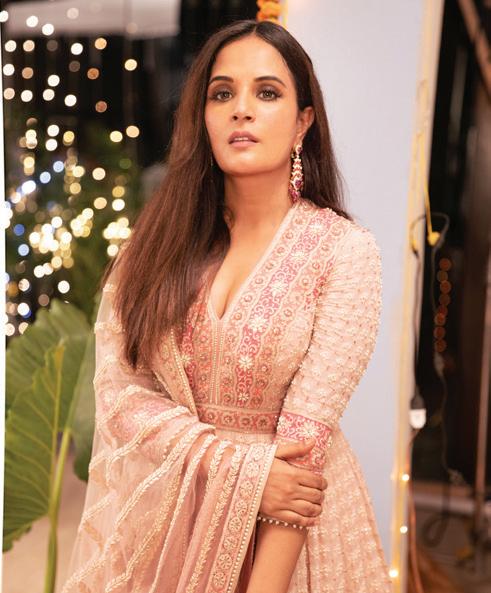
This Diwali is going to be extra special for you, isn’t it? It will be your daughter’s first Diwali!
Yes, absolutely! Her first Diwali is a special one for us. We will dress her in new clothes, perform a small puja at home, and spend quality time with family and friends.
Speaking of your daughter, do you have any cherished Diwali memories from your childhood?


One of my favorite childhood memories is attending the Lakshmi
Poojan celebration at my uncle’s establishment. All the kids in the family would dress up and gather for the puja—it was a very special time. Those moments, filled with love and light, will always remain close to my heart.
Food is a big part of Diwali. What is your go-to indulgence during the festive season?
There is so much food around Diwali that it is difficult to pick, but I guess my all-time favorite indulgence has to be homemade aloo puri.






Diwali is often referred to as the festival of lights. What does the festival signify to you personally?
For me, the true essence of Diwali lies in the simplicity, it is the mitti ke diye , the traditional earthen lamps. I think the most beautiful way to celebrate Diwali is to buy mitti ke diye from local vendors, buy ghee and cotton, and then light these lamps around the house. It’s the most pretty, peaceful, yet powerful way of celebrating the festival. Diwali is also that time of year when everyone meets their family,

no matter how far they stay, and spending time with each other makes the festival even more special.
While Diwali signifies togetherness to you, what message would you like to share with your fans and audience for Diwali?
My message is to celebrate Diwali in the most traditional way possible— like in the olden days. The Diwali celebrated in Ayodhya thousands of years ago was not celebrated with firecrackers. It was celebrated with simple
lights, diyas, and rangolis around the house. On the day of Diwali, Lakshmi is set to visit the houses of people whose lights are the brightest, and I think we should focus on illuminating our homes and our lives from within rather than spending money on crackers and burning cash for a few moments of pleasure. Eventually, what we have to deal with for the next few days is horrible air quality, which is harmful to little children, the elderly, and those who suffer from asthma and other health issues. So, let’s avoid creating noise and air pollution and instead focus on spreading happiness, sharing joy with others, and doing good deeds and charity.



On the topic of light, your performance in Heeramandi was nothing short of luminous—It was a delight to watch you portray Lajjo. As with many of your roles, this character was layered and complex, yet you portrayed it with such conviction and ease. What is your process for delving into such multifaceted roles?

For Heeramandi , a key part of my preparation was studying Meena Kumari’s voice—there's so much pain in her voice, and I tried to channel that into my performance. As for physical preparation, I returned to Kathak, which I learned as a child but hadn’t practiced in years. Beyond the physical training, I also focused on the character's emotional depth. Lajjo was abandoned as a child, so I tapped into feelings of loneliness and a deep yearning for belonging. That desperation and sadness, helped me connect with her vulnerability. I think that’s what resonated with audiences, too. Lajjo feels like a lost soul, and you can't help but feel for her.
You have an impressive career, starting from Oye Lucky! Lucky Oye! to Heeramandi, portraying various diverse and challenging roles. What has been the most rewarding part of your acting journey so far?
It’s hard to say what is rewarding and what is not because there are very obvious rewards of acting or being in Bollywood— fame, awards, and financial success. But for me, the most fulfilling aspect has been the connection I have
formed with audiences. As someone born and raised in India, I love it when I receive feedback from Indian women, or it means a lot to me when people tell me they see parts of themselves in my characters and can relate to them. It happened to me after Masaan , after Gangs Of Wasseypur, and children really loved me in Fukrey. Now, I’d say many women feel deeply connected with Lajjo’s pain, and a lot of people from the LGBTQ+ community also feel connected with her because they understand this one-sided love. So, love and recognition from the audience are incredibly rewarding. I always aim to humanize the roles I take on, even in smaller films like Love Sonia , which is about human trafficking, or Section 375 , where I portray a very upright, moral feminist lawyer who is taken for a ride. Whether or not these films succeed at the box office, I feel a sense of achievement in experimenting with different accents, voices, and character nuances. That truly excites me— challenging myself with something new every time. And that makes me happy as a performer.



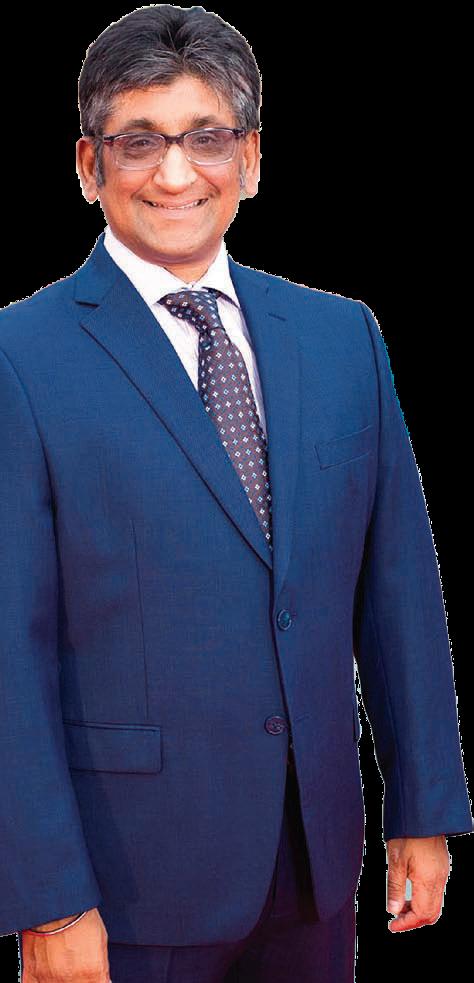
• Divorce
• Nullity / Annulment
• Cohabitation / Separation Agreement
• Pension Division
• Claims Against In-laws
• Child / Spousal Support
• Guardianship / Contact Orders / Custody / Parenting Time
• Asset / Property Division
• Child Apprehension by MCFD
• Assault
• Uttering Threats
• Theft
• Peace Bond (Recognizance)
UNIT 2, 6678 152 ST, SURREY V3S 7J2 ( 66A & 152 ST )

Lucky Oye! and Gangs of Wasseypur to your latest projects, how do you think your approach to acting has evolved over the years?
I think the most significant shift comes from life experiences. As you go through things like pain, loss, heartbreak, or even moments of joy—these experiences shape your craft. I haven’t acted since I became a mother, and now I’m curious to see how this profound change
in my life affects my emotional depth as an actor. Motherhood is the purest, most unconditional form of love, so I’m waiting to explore how that influences my approach to characters. After all, acting is all about conveying the truth through your own experiences, allowing the audience to feel the life you have lived. So, I guess my approach evolves as I go through different stages in life.
Talking about becoming a mom, motherhood brings a
whole new perspective to life. How has becoming a mother impacted your career choices?
I have always been conscious of the roles I take on, and I think motherhood will only deepen that awareness. Now, I'll be more careful about what I’m doing. It won’t limit my choices, but I will be more mindful of my work and the message I send through my roles. I will be more mindful of the impact my work has—what kind of world we are shaping and what values I’m contributing to. People often ask this question, assuming it is about whether I will still take on love stories or bold scenes, but for me, it is less about those specifics and more about the bigger picture.
How has life changed since embracing motherhood?
Life has definitely changed, in that I now carry the responsibility of caring for another human being, and this responsibility can be quite overwhelming at times. However, I’ve learned to adapt to my baby’s needs and demands, which is a significant change.

While there have been many personal changes, you have also taken up a new role on the work front, producing Girls Will Be Girls . Can you tell us more about this project?
The director of the film (Shuchi Talati) and I are longtime friends; we went to college together. And we both wanted to create something meaningful. She is exceptionally gifted and wrote a film that garnered recognition at several script labs. It became like a real winner, even at that early stage. And that gave us a lot of confidence to move forward. We focused on assembling a team of likeminded individuals who shared our vision. The film has already received global awards and will soon be released in India. I’m excited to see how Indian audiences will respond to it.
Are there any other upcoming projects you are excited about? We heard about Abhi Toh Party Shuru Hui Hai , which is set to release next year. Please share more about it.
Anubhav Sinha, and we’ve completed the film shoot, but I’m not sure of the release date yet. But yeah, I will get back to work soon. I need to give my body and my mind some time. Plus, I need to figure out how I can cope with my baby's feeding schedule, how much travel I can accommodate, etc. Once I find that balance, I’m ready to dive back into projects.
Lastly, as someone who is constantly in the public eye, how do you nurture your mental health and well-being amidst the chaos of the industry?
Yes, Abhi Toh Party Shuru Hui Hai is there. It is directed by
I think the key for me is not taking fame too seriously. I understand it comes with the profession, but I don’t let it define me. You could be winning global awards, but acting by nature puts you in the public eye more than most professions. So, I rely on simple, consistent practices like meditation. It has to be a constant, not a one-time fix—you can’t just go to a yoga or meditation camp and expect your life to change. It’s a daily commitment and essential for everyone, not just actors, especially in today's highstress environment. Our lives have been invaded by
gadgets and technology, and it is easy to feel isolated now. Earlier, there used to be a sense of community. Take motherhood, for instance. Had I been living a hundred years ago, in some small town or village, I would’ve been surrounded by a network of mothers— not just my mother, but women in the family and community—offering guidance on everything from breastfeeding to postpartum care. That wealth of shared knowledge has diminished in modern life, and that isolation adds to our stress. When you look at the bigger picture—how our cities are structured, the stress of public transport, the food we eat—it’s clear that we’re navigating many challenges that humans didn’t have to deal with for most of our existence. So, it’s essential to recognize these shifts and ensure care for our mental health in this fast-paced world.
On that note, we sum up this interview with this firebrand actress. May her light continue to shine brightly, both in her performances and life. Happy Diwali!



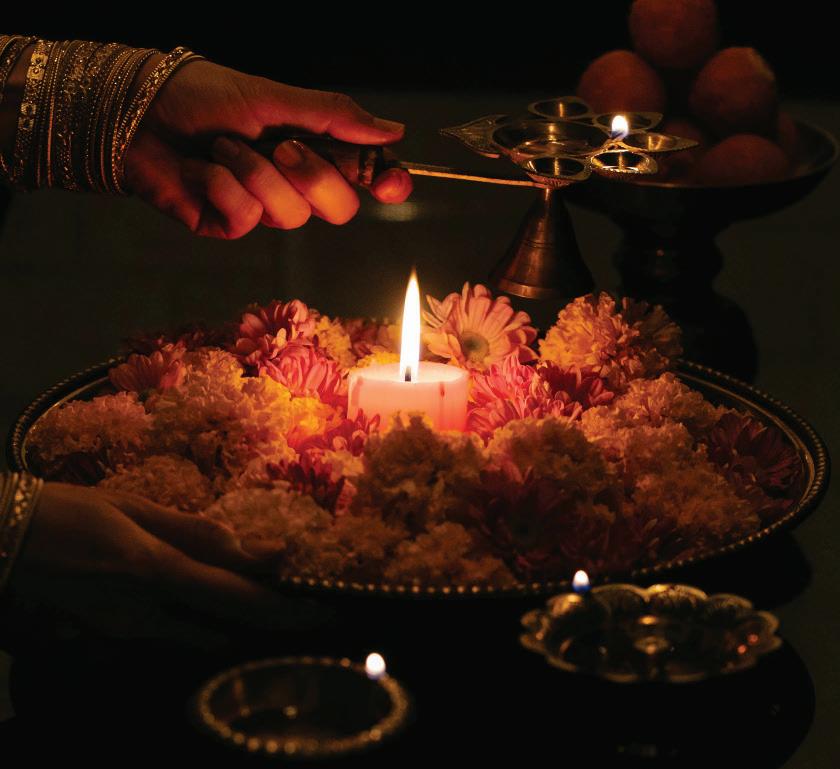
By Mrinalini Sundar
Diwali, the festival of lights, is just around the corner. While everyone is already in the festive mood, shopping for their Diwali outfits and redecorating their homes, how we celebrate Diwali has evolved. When you think about Diwali, one of the first things that often comes to mind is how we celebrated it when we were younger. From starting the day with an oil bath and wearing new clothes to bursting crackers, enjoying hearty meals, inviting relatives and friends over, exchanging gifts, and hosting parties—the grand celebrations have changed over the years.
While the enthusiasm to celebrate Diwali in the best way possible remains unchanged, many ancient Diwali rituals have faded away, lost in the hustle of modern life. These traditions, steeped in regional, cultural, and spiritual significance, offer a glimpse into the more intricate, intimate, and community-driven aspects of Diwali. Listed here are some of the ancient traditions that have gradually faded into the background.





























While Lakshmi Puja is widely performed during Diwali, many lesser-known rituals dedicated to other deities have faded over time. In West Bengal, Kali Puja, once essential for driving away negative energies before welcoming prosperity, has become less common, though some still observe it.
In Tamil Nadu, families traditionally performed Govardhan Puja, worshipping an earthen mound symbolizing Mount Govardhan. This ritual has mostly disappeared and has now been overshadowed by other Diwali customs.
Similarly, Vishwakarma Puja, a tribute to the divine architect, was once central in artisan communities to bless tools and instruments. Today, it is mainly limited to industrial settings and is far less prevalent among traditional artisans.
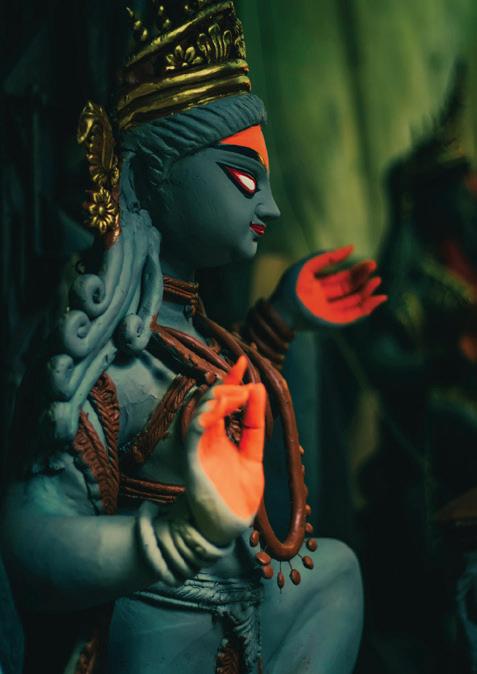
Folk songs, in general, have played a significant role in Indian culture, and Diwali was no different. In ancient
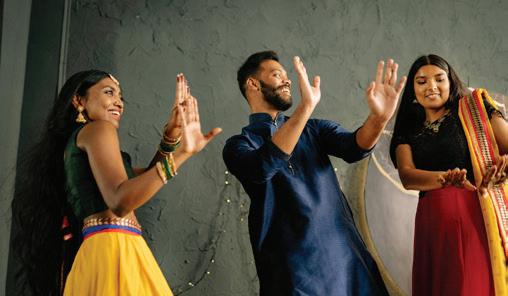
times, Diwali was marked by communal gatherings where ‘Diwali Geet’ were sung to praise deities like Lakshmi, accompanied by instruments like the dholak or mridangam.
In Maharashtra, Diwali Pahat featured early morning concerts, fostering community spirit, but such events are now rare, replaced by modern entertainment. Similarly, in Gujarat and Rajasthan, the traditional slower-paced Diwali Garba dance has shifted towards Bollywood music, moving away from its original songs.
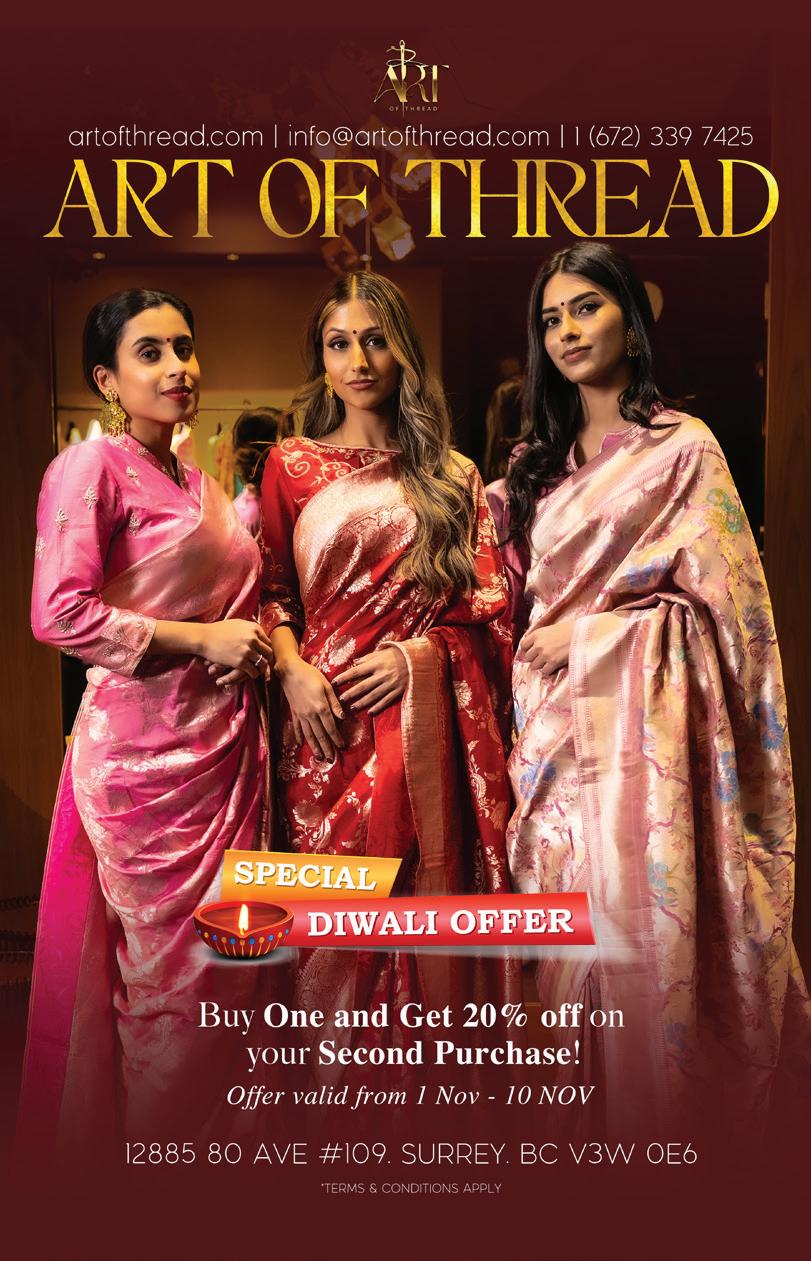
One of the first things that strikes us when we say Diwali is card parties. While card games have become a popular Diwali tradition, particularly in northern India, ancient Diwali celebrations were marked by simpler, more culturally significant games. In many regions, instead of playing cards, people played games of chance with cowrie shells.
In states like Gujarat and Madhya Pradesh, playing with cowrie shells during Diwali was a symbolic practice representing life's unpredictability and fate's role in human affairs. Players would toss shells, predicting their outcome, which was a way of seeking divine blessings for wealth and prosperity. Over time, card games involving money have overshadowed this ancient tradition, leading to the decline of this sacred form of gaming.
What’s Diwali without sweets and savories? Although the festival of lights is synonymous with mithais and namkeen, many regions have unique culinary customs that do not necessarily revolve around sweets.


In Kerala and parts of Karnataka, simple, healthy meals were traditionally prepared during Diwali, avoiding rich, decadent sweets. Unique rice dishes, lentil soups, and vegetable curries were the focus, with sattvic food believed to
cleanse the body and mind.
In Rajasthan, some families avoided sweets during Diwali, viewing it as a time for introspection and reserving sweets for New Year celebrations. Today, however, Diwali is all about indulging in sweets and savories.
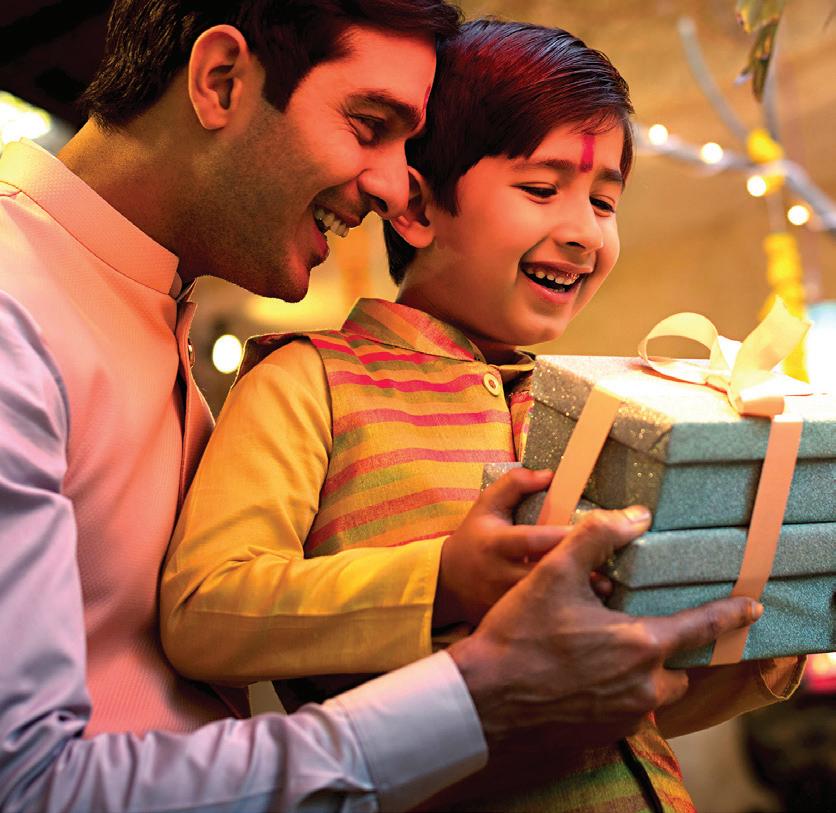

Another tradition that is being largely forgotten is lighting earthen diyas in sacred groves, known as ‘devrai’ in Maharashtra. These groves were considered the abode of local deities, and lighting lamps were believed to invoke their blessings for a bountiful harvest and protection from calamities. This practice, which connected people with nature and their spiritual surroundings, has faded mainly due to urbanization and the destruction of these sacred groves. However, today, most people light diyas in their homes.














As we celebrate Diwali this year with fireworks, sweets, and lights, it is worth pausing to reflect on the rich tapestry of traditions that have faded away. These ancient rituals offered a deeper spiritual connection and fostered community bonding, environmental awareness,


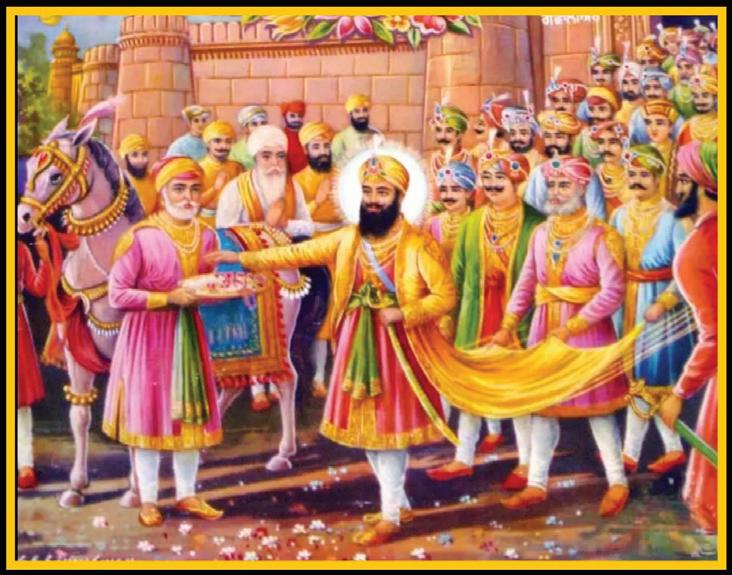
BBy Naina Grewal
andi Chhorh Divas, a festival celebrated by Sikhs and devotees around the world, is a time of joy, reverence, and reflection on the values of freedom and compassion. With roots tracing back to the early 17th century, the tale unfolds at a time when Guru Hargobind Ji, the sixth Guru, was imprisoned in the Gwalior Fort by Emperor Jahangir. The Mughal ruler saw Guru Hargobind Ji’s influence as a potential threat and detained him. While in prison, the Guru’s spiritual presence inspired many, including 52 Rajput kings who were also imprisoned at the fort. After a period of detainment, Emperor Jahangir eventually ordered Guru Hargobind Ji’s release.


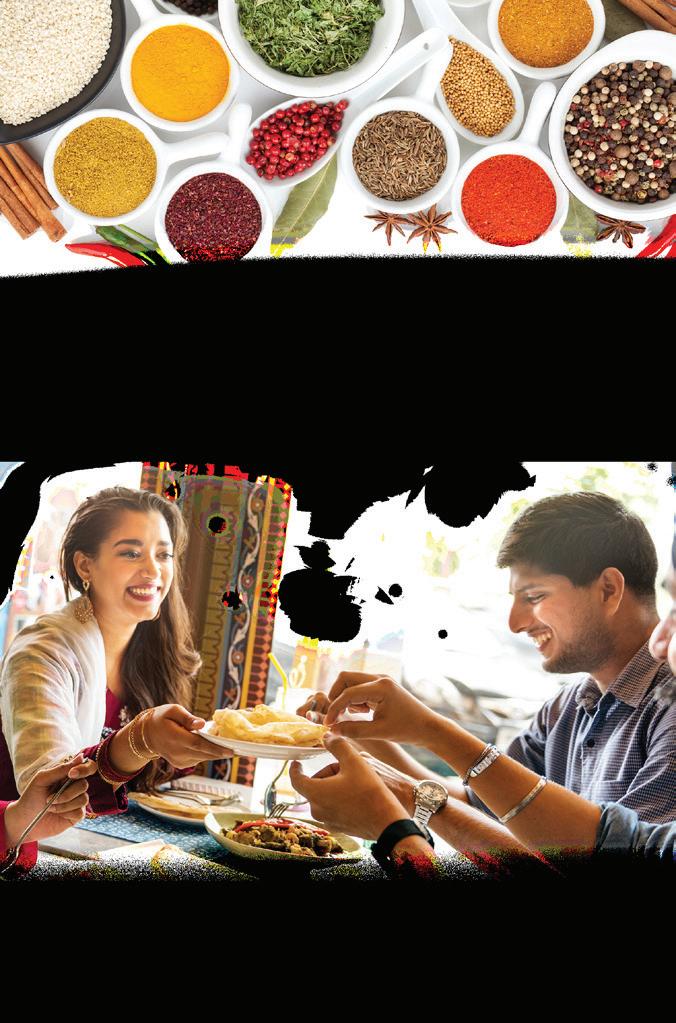




However, Guru Hargobind Ji refused to leave unless the 52 kings were also freed alongside him. The emperor agreed, but only on the condition that those who could hold onto Guru Hargobind Ji's cloak would be released. To fulfill this condition, Guru Hargobind Ji had a special cloak made with 52 tassels, allowing each king to hold onto one and walk out of the fort with him. This moment of collective liberation became known as Bandi Chhorh Divas, translating to ‘day of the release of prisoners.’
Bandi Chhorh Divas coincides with Diwali, sharing a similar theme of light triumphing over darkness. The festival is celebrated with fervor, particularly at the Golden Temple in Amritsar, where the temple is illuminated with thousands of lights. Even today, Bandi Chhorh Divas holds a special relevance as its themes of justice and resilience resonate with the ongoing struggles for human rights and equality.
The story of Bandi Chhorh Divas has deep spiritual significance, emphasizing selflessness, justice, and the welfare of all. Guru Hargobind Ji’s refusal to secure only his freedom and his commitment to the release of others embodies the ideal of working for collective well-being. It serves as a timeless reminder of the importance of standing up against injustice, advocating for the oppressed, and prioritizing the greater good over personal gain.
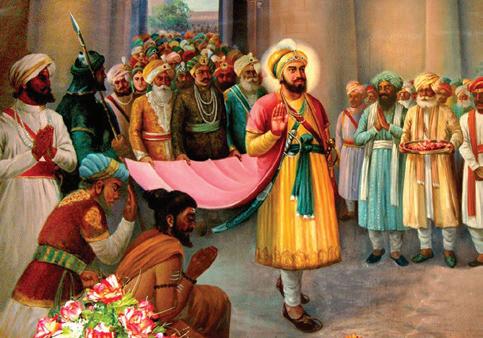
This essence of collective welfare serves as a powerful inspiration, reminding us that true leadership is about lifting others and striving for a more equitable society, especially significant in a world where many face various forms of injustice, discrimination, and social challenges. As such, it is essential to understand that celebrating any festival, for that matter, is not just about remembering a historical event but also about drawing strength from its teachings to address modern issues.
Fostering a sense of identity and continuity in a rapidly changing world, Bandi Chhorh Divas provides an opportunity to reflect on the importance of values like community and service, which are just as relevant today as they were centuries ago. In today's world, challenges like social media's divisive influence, political unrest, economic inequality, and rising polarization can be viewed through such compassion, encouraging us to confront these issues with a sense of responsibility, unity,
and inclusivity, even in times of uncertainty.
Undoubtedly, the spirit of freedom is universal and timeless. Seeking the freedom of others is as crucial as securing one’s own, a principle that continues to inspire movements for social justice around the world. As we gather to light candles and offer prayers, let us commit to embodying all that Guru Hargobind Ji sought to teach us through his actions, adorned with values that teach us to be resilient, understanding, and evermindful of the struggles of others. Bandi Chhorh Divas is thus not only a celebration of historical significance but also a living tradition that continues to guide and inspire in the quest for a more just and compassionate world.





Diwali, the festival of lights, has undergone a profound transformation in Canada in the last few decades. Once celebrated more intimately within the South Asian community, the festival today has blossomed into a grand, inclusive event embracing a multicultural spirit. This evolution is reflective of the shifting demographics, cultural integration, and vibrant South Asian diaspora that has made Canada home.

Rewinding to the past, the South Asian population in Canada was smaller and more concentrated around neighborhoods like Main Street in Vancouver. Back then, Diwali celebrations were close-knit and centered around community hubs and religious gatherings. Sulakhan and Kulwinder Ark, who moved to Canada in 1974, recall, “There were fewer people from the South Asian community back then, and most of the Diwali celebrations, including fireworks and Bhangra, took place around Main Street in Vancouver. Now, it's all moved to Surrey.” As the community grew, Surrey became a new epicenter of
By Naina Grewal

South Asian culture, hosting large-scale Diwali events and drawing thousands. With the rise of the South Asian diaspora in Canada, Diwali celebrations have grown beyond religious observance, becoming massive cultural events. Now, streets are adorned with festive lights, sweet shops are abuzz with customers, and large fairs attract both South Asian and non-South Asian attendees alike. The celebrations feature everything from traditional food stalls to vibrant Bhangra performances,








offering a taste of home to those who have moved miles away.
Sarabjeet Kaur, who moved to Canada in 1989, reflects on how the celebrations have changed: "Back then, we only went to the Gurdwara Sahib and would invite one or two families over for dinner, maybe. There wasn't as much of a craze, and fewer sweet shops were around, too. Now, it's a totally different scene, with families and businesses participating in the festivities. Our community’s celebrations have grown significantly. It feels good that our cultural and religious days are now widely celebrated.” For families like hers, Diwali
in those years was a quiet affair, marked by visits to the Gurdwara and small gatherings at home. Today, the scope has expanded dramatically.
The celebration of Diwali has also become more inclusive. With growing multiculturalism, Diwali is celebrated across schools and educational institutions in the Lower Mainland. This includes activities such as dance performances, sharing traditional foods, dressing up in ethnic wear, and coloring sheets featuring clay lamps and rangolis. Students of various backgrounds learn about the festival’s significance, making Diwali an

educational experience as well as a cultural celebration. Such activities help younger generations understand the traditions, even if they are far from their ancestral roots.
At its core, Diwali remains a time for families to come together, reflect on the triumph of light

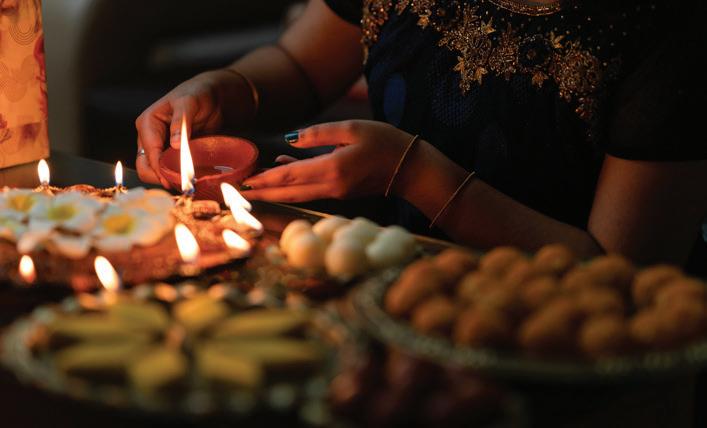
over darkness, and spread joy. Even as the scale of celebrations has grown, the fundamental message of Diwali endures, adapting to the new contexts of Canadian life while retaining its deep cultural roots.
Moreover, the Canadian government, including Prime Ministers and other prominent officials, has increasingly recognized and celebrated Diwali through official statements and social media messages. By joining in the celebration of Diwali and other cultural festivities, government leaders emphasize the contribution of various communities in shaping Canada’s multicultural identity, reinforcing the nation as a place where diverse traditions are not

only respected but also embraced.
The journey of Diwali from small gatherings to city-wide celebrations in Canada mirrors the broader story of the South Asian diaspora— one of resilience, cultural pride, and a willingness to share traditions with a wider audience. Today, Diwali not only serves as a celebration
of light but also as a testament to how cultural traditions can thrive in a new land, contributing to Canada's rich multicultural tapestry.


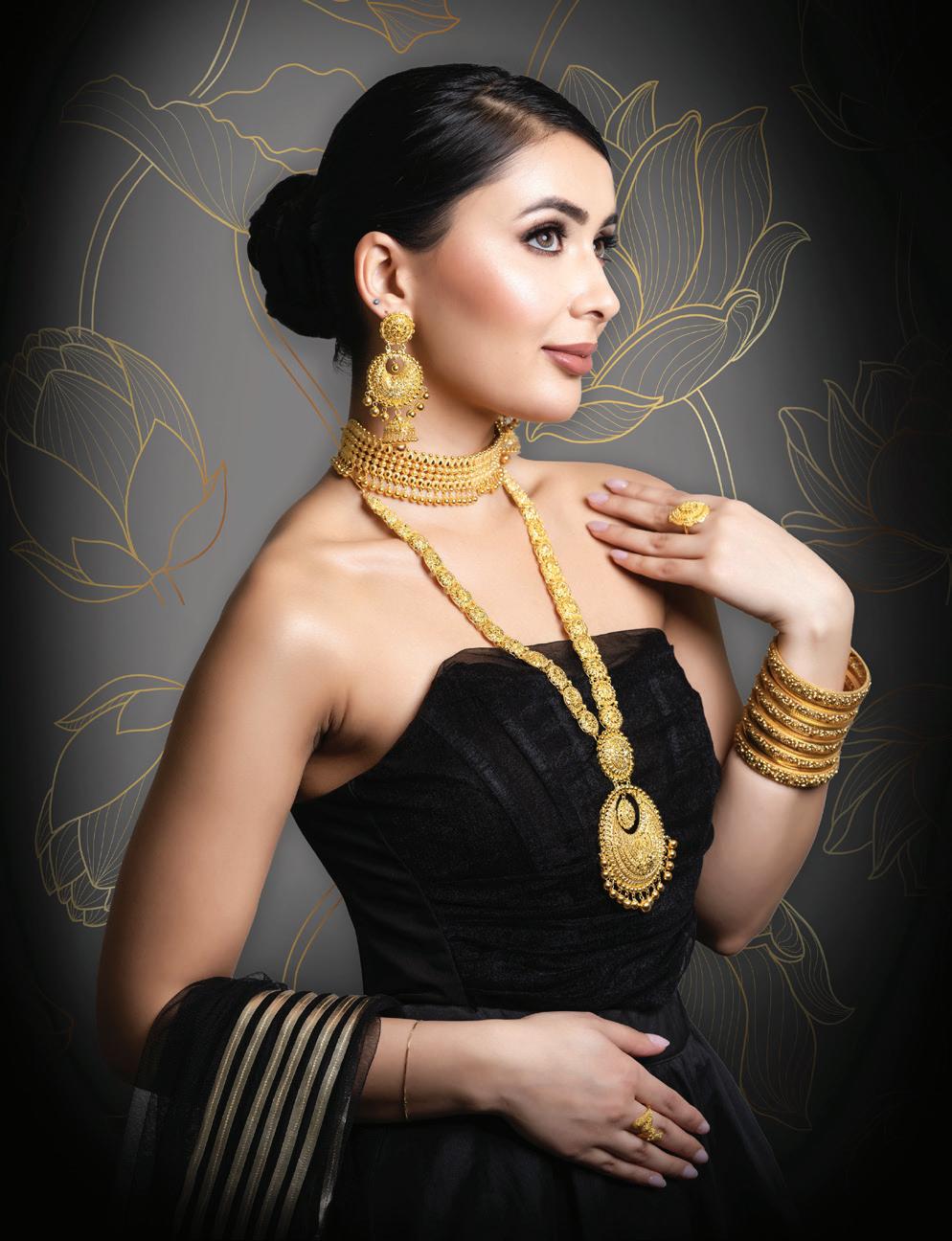












By Natasha D’souza
Diwali, the festival of lights, is more than just a celebration of good triumphing over evil. It’s a moment when families can step away from the frenetic pace of everyday life and reconnect with what matters most - each other. It’s a festival that doesn’t just illuminate homes but also strengthens relationships, bringing families closer and ensuring that traditions are passed down to younger generations in meaningful ways.



In today’s fast-paced world, finding time to spend with loved ones can be difficult. However, Diwali offers the opportunity to slow down and engage in fun activities that foster bonding. From decorating the house with sparkling diyas to preparing festive sweets, each ritual is a chance to create joyful memories. For parents, Diwali is a great time to instill values and traditions in their children. Explaining the festival’s significance becomes a shared adventure, ensuring that its deeper meaning isn't lost in the noise of modern life.
While ancient tales of good triumphing over evil remain relevant, Diwali holds a unique place in modern times. The battle between good and evil may not involve demons and warriors anymore, but it reflects daily struggles - whether it's the fight for justice, kindness, or balance in a demanding world. Diwali reminds us that goodness prevails, and this message resonates deeply today.
While the sweets, decor, treats, and festive fashion are beyond compare, below are activities that can add fun to the frolic while inspiring multi-generational bonding time:
Transforming the home into a bright and inviting space is one of the most enjoyable parts of Diwali. Families can host a DIY decor party where everyone contributes ideas for homemade decorations and creates rangolis, paper lanterns, and garlands of marigold flowers. This activity builds teamwork and creates cherished memories that will last for years to come.


Flash of Fame: Organize a family talent show where everyone showcases their unique talents, whether it’s singing, dancing, or performing magic tricks. Record the performances to create a memorable family video to cherish later. You can keep it virtual, too, to ensure no one feels left out!
Gratitude Board: Set up a board where family members can write notes of gratitude for each other and the community. This can foster positive conversations about appreciation and kindness, especially during the giving season.
Lyric Lollapalooza:
Organize a karaoke night featuring songs related to Diwali or Bollywood hits. Add a twist by having family members perform in teams or incorporating funny skits into their performances.
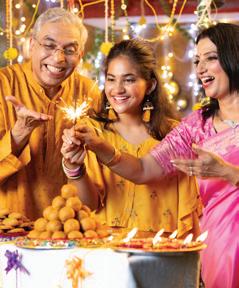
Create a Diwali
Scrapbook: As a family, start a scrapbook documenting your Diwali celebrations. Include photos, drawings, and messages about what each family member appreciates about Diwali. This will be a cherished keepsake that could be passed on to future generations.
One of Diwali’s most important gifts is the opportunity to be truly present. In an age where
captcha validates us as humans, let this season ensure that nothing pulls us away from genuine ‘humane’ connections. By engaging in meaningful conversations, participating in shared activities, and simply enjoying each other’s company, families can use this time to strengthen their relationships.
Diwali isn’t just about the lights or rituals; it’s about creating space for what truly matters. It serves as a reminder to be grateful for the people in our lives and to prioritize those connections, even when life feels overwhelming. Every diya lit, every sweet shared, and every story told is a chance to create memories that will be cherished for years to come.






















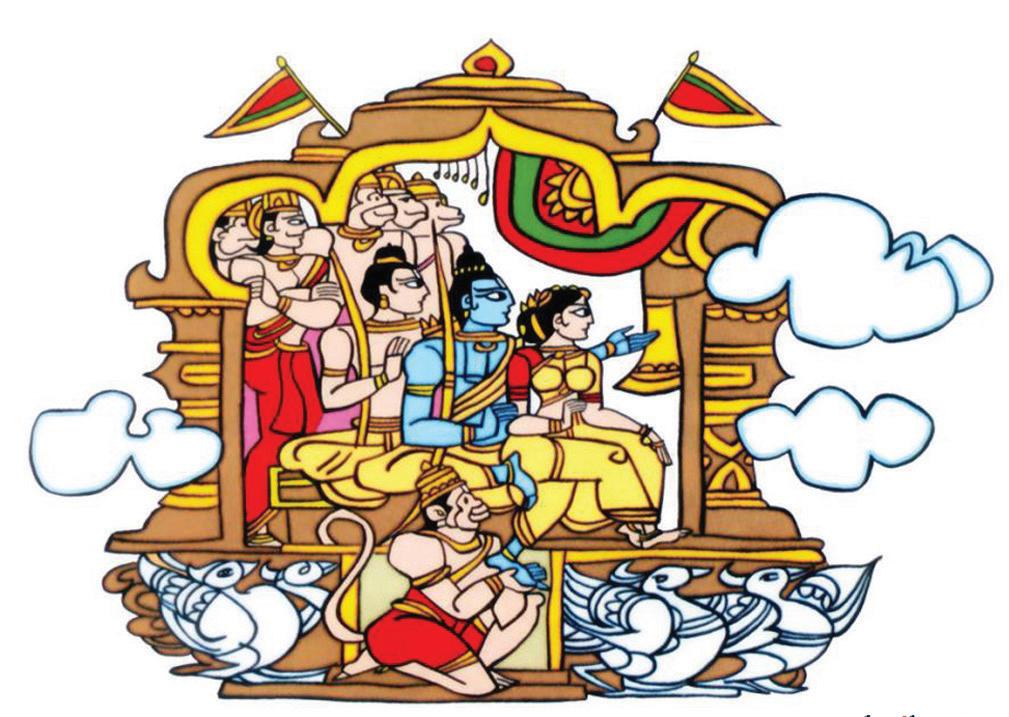
Diwali is centered on a very fundamental concept of the victory of good over evil.
DBy Gurleen Kaur Bajwa
iwali, annually falling between mid-October to mid-November, is celebrated in many ways and by millions of people from all walks of life. It has its roots in drastically broad cultural and religious values.

Diwali is one of the most prominent holidays in Hinduism. It relates to the Hindu epic, Ramayana, which centers around Prince Rama, the avatar of Vishnu. Diwali celebrates the day of the return of the beloved Prince Rama from a 14year exile, after the defeat of the demon king Ravana. The people of Ayodhya lit up the streets with lamps and fireworks, welcoming their prince home. The day is also associated with

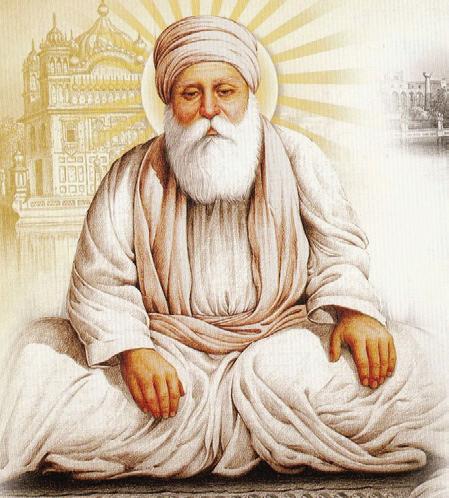

Lakshmi, the wife of Vishnu and the goddess of wealth and prosperity. Several customs such as cleansing of the home, Lakshmi puja , and setting up plates of sweets for the goddess are often followed. Hindus of eastern India associate the day with goddess Durga, while others in northern India associate it with Krishna, both of whom
symbolize the victory of good over evil. Diwali, also known as Bandi Chhor Divas in Sikhism, is celebrated for similar reasons as Diwali in Hinduism. The day marks the release of the sixth guru, Guru Hargobind Ji , from the Gwalior Fort prison, along with 52 Rajput kings, by the
Mughal emperor Jahangir. However, what many may not know is that the importance of Diwali in Sikhism actually goes further back.
The third guru, Guru Amar Das Ji , had built a well in Goindwal with 84 steps, a famous place of pilgrimage even now, and invited Sikhs to bathe there on Vaisakhi and Diwali. Moreover, Diwali also relates to two other key events in Sikh history; it is the day of the founding of the city of Amritsar, and Bhai Mani Singh’s martyrdom was brought on by a failure to pay a fine imposed in 1738 for celebrating Diwali, and his refusal to convert to Islam.
Both Buddhism and Jainism also have unique customs and histories linked to Diwali. The festival is not as widely celebrated in Buddhism as the aforementioned, except perhaps in Nepal and Newar. Several deities in the


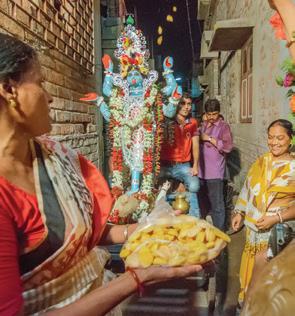

Sikhism and Hinduism host perhaps the more prominent and well-known forms of celebration associated with Diwali. However, both Buddhism and Jainism also have unique customs and histories linked to Diwali.

Vajrayana Buddhism are worshipped and Lakshmi is also offered prayers. In Jainism, Diwali is observed for ‘Mahavira Nirvana Divas’, in remembrance of the physical death of Mahavira. There are some similar practices to Hinduism in which the customs include the lighting of diya and praying to Lakshmi. The focus, however, remains on Mahavira. According to Jainism, the tradition of the lighting of the lamps began at the passing of Mahavira. The 18 kings who had gathered started the practice in remembrance.
Diwali has another, more westernized definition as well; the Festival of Lights, which aptly captures the hope and goodwill attached to the many interpretations. Additionally, despite these
different interpretations, Diwali is centered on a very fundamental concept of the victory of good over evil. There is a common theme of righteousness and of overcoming the darkness in whatever form it might take in our lives.
Diwali helps remind those who celebrate it, that despite their differences, they share a respect for a strong moral code, that resonates across cultures.



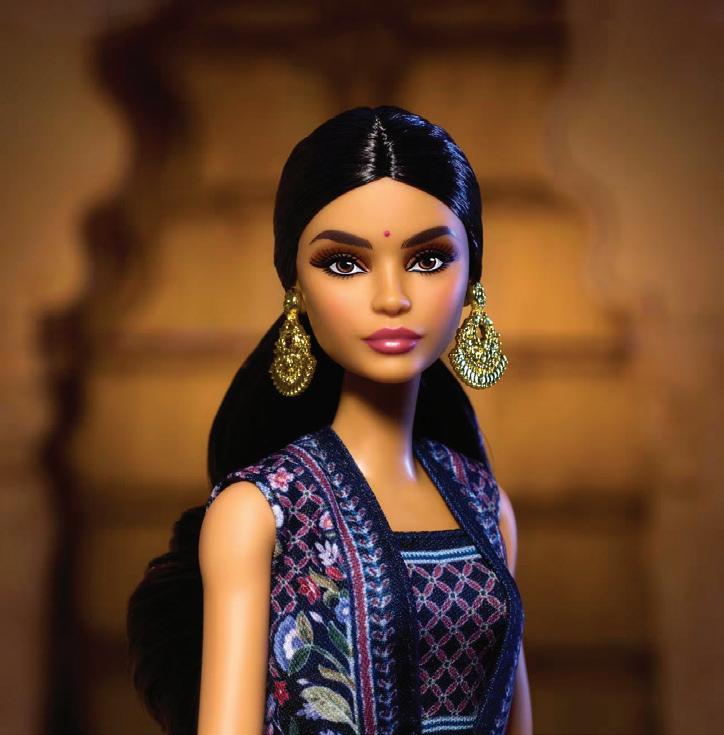
By Ancy Mendonza
Diwali, the festival of lights, has long transcended its roots in South Asia and is now a celebration spread over several continents. Its universal themes of light triumphing over darkness and new beginnings resonate far and wide, inspiring global brands to launch limited-edition Diwali capsules year after year. With irradiant jewelry edits and cosmetic products shaped like sparkling diyas, here’s a look at how global brands celebrate Diwali's spirit with style and fervor.















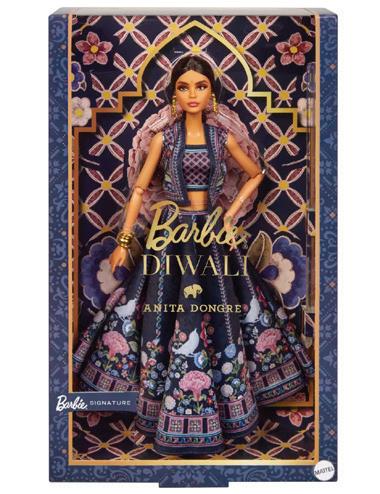

Barbie has long been a cultural icon, representing fashion and culture through its costumes, and makes an excellent gift for collectors and celebrants. Together with one of India’s top fashion couturiers, Anita Dongre, this Barbie is dressed in a breathtaking lehenga inspired by her ‘Midnight Bloom’ collection, complete with dazzling gold accessories and shoes. The lehenga features a choli top, a floral koti vest, and a lehenga skirt adorned with dahlias, jasmines, and lotuses, perfectly capturing the brilliance of Diwali. This collectible doll also honors rural women artisans of India who bring Anita Dongre’s exceptional designs to life. This is not just a doll—it’s a festive sentiment that every brown girl would relate to, now and in the future.
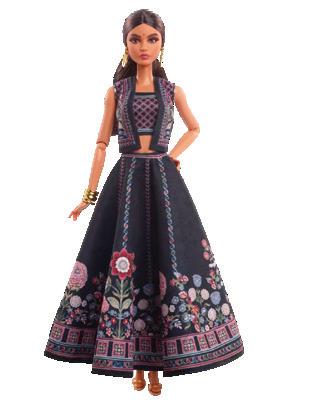

Swarovski, known for its sparkling elegance, introduced a unique Diwali collection, mirroring the traditional art of rangoli in its designs. The Idyllia collection, fronted by Swarovski India’s ambassador Ananya Panday, features intricate designs in vibrant colors, crafted in rose-gold metal and festive patterns original to Diwali. This collection is sure to add a modern, luxurious touch to the traditional festival, making it a perfect gift for loved ones.









Lush Cosmetics is known for its enriching and ethical approach to beauty, and its 2024 Diwali collection highlights similar themes of light over darkness and unity across the world. Their Diwali collection includes a Lotus Blossom Bath Bomb, a Diya Bath Bombshell, a Sparkling Light Shower gel, an Embers of Joy Knot Wrap, and a gift kit. Each product in the lineup reflects the Diwali vibe and is a representation of Indian culture. With a focus on diversity and inclusion, Lush Cosmetics’ Diwali collection is perfect for anyone looking to sustainably celebrate the festival of lights.
Famous French designer Christian Louboutin once said he could do an India-inspired collection for 100 years without repeating himself. His deep admiration for Indian aesthetics can also be seen in this 2024 Diwali Edit, featuring a limited-edition lineup of shoes and accessories for the Diwali season. Inspired by the exuberance of the festival, each item is a riot of color, blending deep fuchsia, rose, teal, and earthy tones of yellow and red. This striking color palette, along with Louboutin’s exquisite attention to detail, celebrates India and the joy that this festival brings.



From designer dolls to shimmery shoes and accessories, these brands along with many others, prove that Diwali is more than just a South Asian festival; it is now a global celebration of light over darkness. By coming up with limitededition products that reflect Diwali, they help South Asians across the world celebrate this festival with beauty, tradition and creativity that ultimately brings us all together.











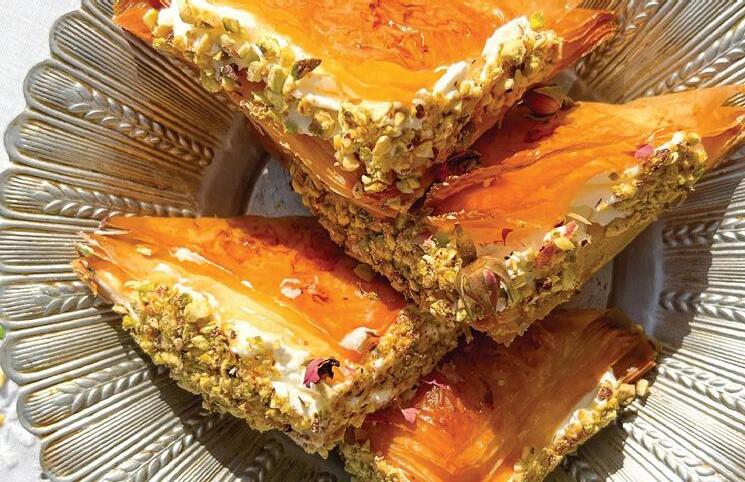
For Gajar Halwa
• ½ kg grated carrots
• 3 tablespoons ghee/clarified butter
• ¼ teaspoon cardamom powder
• 1 cup milk
• ¾ cup sugar
• 1 cup crumbled khoya
• 2 tablespoons mixed chopped nuts
For Baklava
• 1/2 cup melted butter
• Phyllo sheets
• 1/3 cup walnuts
• 1/3 cup sliced almonds
• 2 tablespoons chopped pistachios
• 1 teaspoon ground cloves
• 1 teaspoon ground cinnamon


By Chef Gurkirat Singh@masterchef_gurkirat
For Sugar Syrup
• 1 cup water
• ½ cup sugar
• 3 tablespoons honey
• 1 tablespoon lemon juice
• 1 teaspoon kewra essence
• 2 tablespoons chopped pistachios
For Gajar Halwa
• Add ghee and grated carrots in a pressure cooker, and cook for 5 minutes.
• Add milk and sugar, stir well, and pressure cook for five whistles. If needed, cook for two more whistles.

• Open the lid and keep cooking till excess moisture evaporates.
• Finally, add the khoya and cardamom powder and mix well. Add the chopped nuts and let it cool completely. Place it in the fridge until you're ready to use it to make the Baklava.
• Take readymade phyllo sheets and cut them into long rectangles.
• Brush ghee on the sheet, place a spoonful of gajar halwa in one corner, and fold the
sheet into a triangle. It should look like a samosa but with multiple layers of the sheet.
• Finally, brush ghee on the top and bake it in a preheated oven at 350°F for 12-15 minutes.
• Add sugar and water to a pan and let it boil for about 10 minutes, or until the sugar syrup reaches one-string consistency.
• Switch off the flame and add honey, lemon juice and kewra essence.
• Pour this sugar syrup on hot baklavas.
• Garnish the Baklavas with chopped pistachios and serve
• Make regular rice kheer and flavor it with saffron.
• Blitz it well, adding some milk to loosen the consistency and make it like a sauce.
• Strain it or pass it through a sieve to achieve a smooth consistency.
• Serve this sauce with Gajar Halwa Baklavas.



RAVINDER R. S. UPPAL *PERSONAL LAW CORPORATION AT UPPAL

■ GUARDIANSHIP / CONTACT ORDERS / CUSTODY / ACCESS
■ ASSET / PROPERTY DIVISION
■ DEBT COLLECTION MATTERS General Civil Litigation
■ MAJOR ICBC CLAIMS
■ MEDICAL & DENTAL MALPRACTICE
■ EMPLOYMENT DISPUTES
■ PRIVATE INSURANCE DISPUTES
■ DEFAMATION
ASHLEY A. ATHWAL *PERSONAL LAW CORPORATION

■ FRANCHISE & LEASE DISPUTE
■ ESTATE LITIGATION & WILLS VARIATION CLAIMS Estate
■ PREPARATION OF WILLS & RELATED DOCUMENTS
■ BUYING AND SELLING PROPERTY

For Granola
• 2 cups rolled oats
• ¼ cup chopped walnuts
• ¼ cup unsweetened coconut flakes
• ¼ cup almonds
• ¼ cup pumpkin seeds
• ¼ cup brown sugar
• ¼ tsp cinnamon
• ½ cup dried cranberries
• ½ cup Coconut oil (can be replaced with Olive oil)
• ½ cup water
• ¼ cup honey
• ½ tsp salt
• ½ tsp vanilla extract


By Chef Gurkirat Singh@masterchef_gurkirat
For Pineapple Shrikhand
• 2 cups hung curd/Greek yogurt
• ½ cup powdered sugar
• 1 cup pineapple puree (fresh or canned)
• Saffron strands
For Granola
• Preheat oven to 300°F for 10 minutes.
• Mix all the wet ingredients, i.e., water, oil, honey, vanilla essence, and salt, together and heat well. Don’t boil.
• In another bowl, mix all the



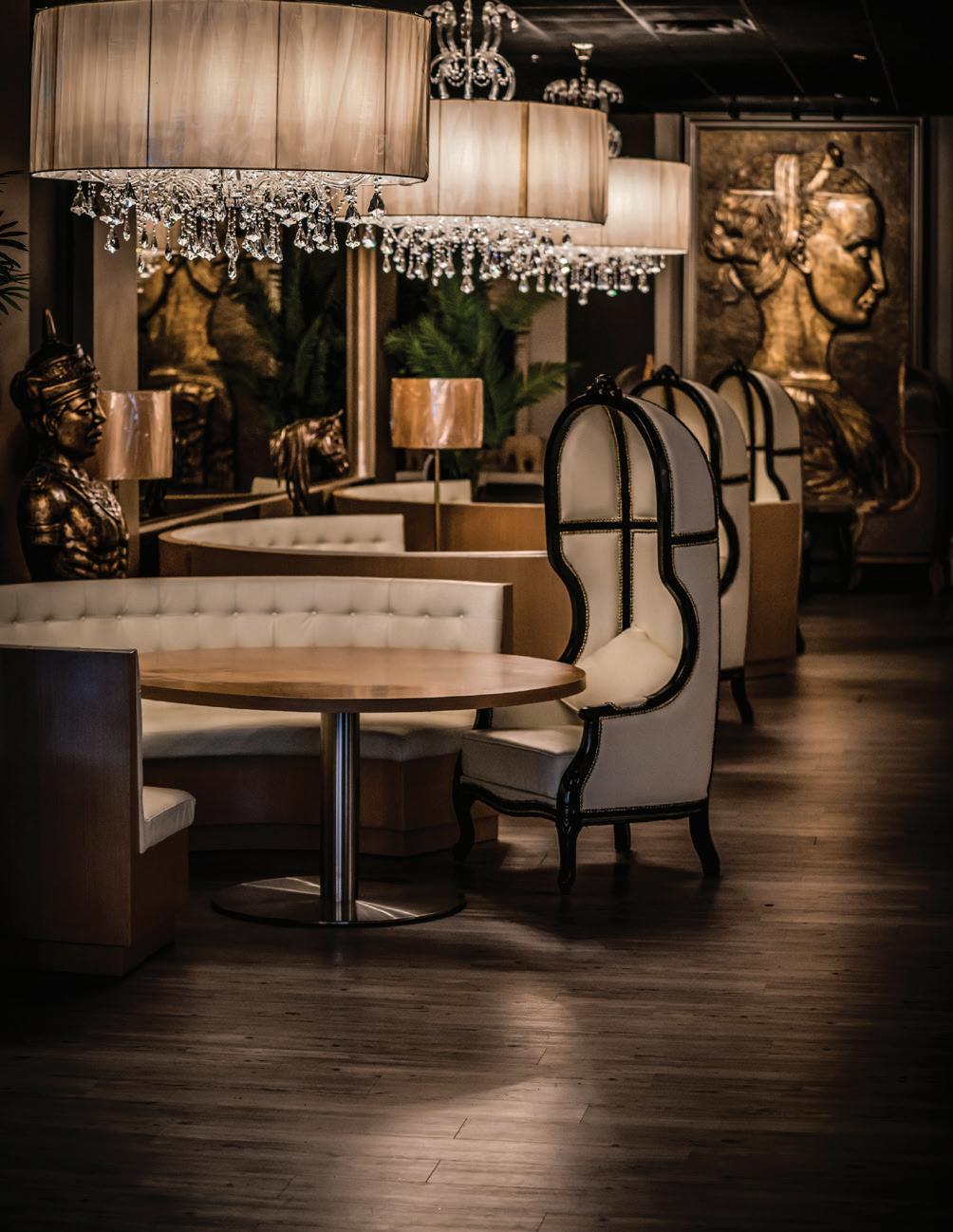
dry ingredients, i.e., oats, nuts, seeds, cranberries, brown sugar, coconut flakes, and cinnamon.
• Pour wet ingredients over dry ingredients and mix everything well.
• Spread this mixture on a lined baking tray and bake it at 300°F for about 30-35 minutes, gradually mixing in between.
• Let it cool down completely. It will become crunchy.
• Whisk sugar and pineapple puree into hung curd or yogurt and refrigerate it to let it chill.
• Toast saffron strands over a hot tawa. Crush them, soak them in lukewarm milk, and mix them in the yogurt mixture.
• In a glass jar, place granola and pipe Shrikhand on it.
• Top it up with fresh-cut pineapple and seeds.
• Garnish it with some saffron and serve chilled.



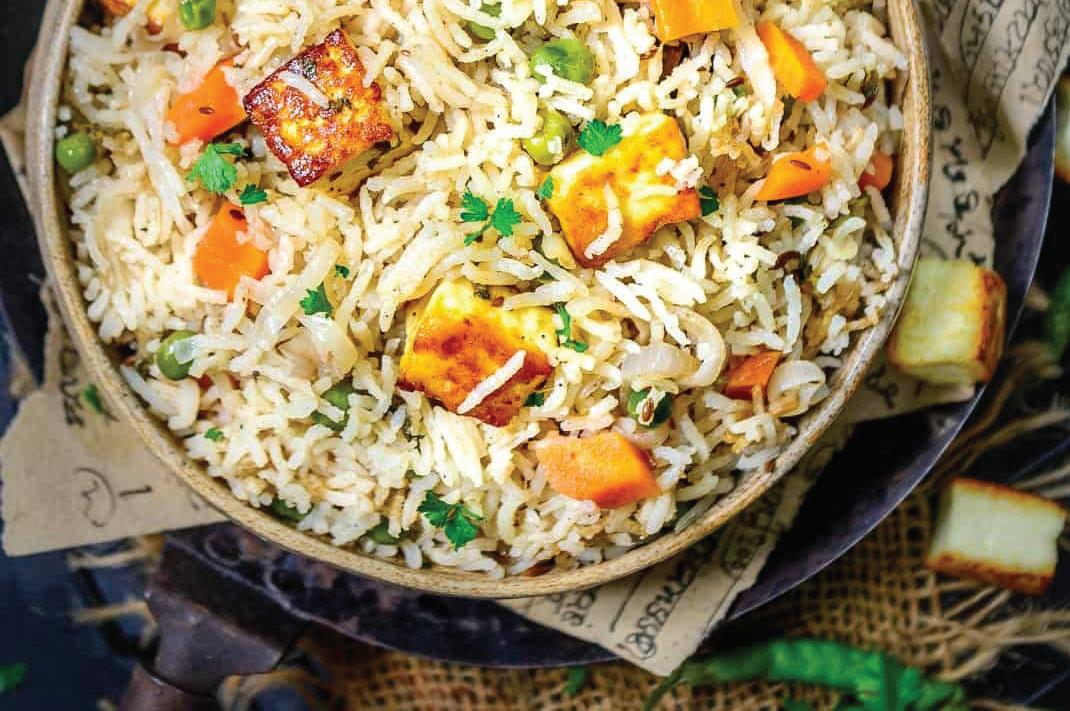
For Pulao
• 2 cups Basmati rice
• 2 cups Gobindobhog rice
• 1 cup poppy seeds
• 100 gms khoya
• 2 cups hot milk
• Saffron strands
• 250 gms paneer, cut in small pieces
• 200 gms carrot, chopped finely
• 1 cup peas
• 3 tbsp ghee
• 1 cup cashew nuts, separated in halves
• 1 cup almonds
• 1 cup raisins
• salt to taste

By Chef Gurkirat Singh@masterchef_gurkirat

• 2 bay leaves
• 2 1-inch pieces cinnamon sticks
• 1 tbsp peppercorns
• 4 pieces cardamom, only use the seeds
• 3 pieces cloves
• Fresh pomegranate seeds
• Coriander
For Raita
• Beetroot
• Rose petals
• Rose water
• Roasted cumin seeds
• Black salt
• Powdered sugar
• Curd
• Red chili powder

• Wash and soak the rice for 15 minutes. Soak saffron strands in warm milk.
• Boil enough water in a heavy bottom vessel, and add soaked rice.
• Add poppy seeds and the juice of 1/2 a lemon. Cook till the rice is 3/4th done. Drain and keep aside.
• In another vessel or earthenware, add ghee and all the dry spices and sauté for a minute.
• Add all the vegetables,
except pomegranate seeds, and cubed paneer pieces, and cook until the edges of the paneer turn brown. Then add khoya and roast it well.
• In another pan, roast all the dry fruits and add them to vegetables.
• Slowly add the cooked rice and salt as per taste and mix gently. Pour saffron milk over the rice.
• Cover and cook on low flame for 15-20 minutes.
• Serve hot with raita.
• Grate a boiled beetroot and chop rose petals.
• Add powdered sugar and salt to curd and whisk it well.
• Add the grated beetroot and chopped rose petals to the curd and mix well. Add rose water when everything else is mixed well.
• Garnish it with roasted cumin and rose petals.
• Serve chilled with phulkari pulao.




For Couscous
• 1 cup water + ½ cup coconut milk
• ½ tsp salt
• 2 tbsp extra-virgin olive oil
• 1 cup instant couscous
For Salad
• ½ cup diced cherry tomato, ¼" pieces
• ½ cup diced English cucumber, ¼" pieces
• ½ grated fresh coconut
• ¼ cup chopped red onion
• ½ cup olives, pitted and sliced
• 2 tbsp feta cheese
• 1 tsp chopped parsley
• 1 tsp chopped mint


By Chef Gurkirat Singh@masterchef_gurkirat
• 1 tsp orange zest
• ¼ cup orange juice
• 1 tbsp vinegar
• ¼ tsp salt
• ¼ tsp black pepper
• 3 tbsp coconut oil
For Couscous
• Bring water, coconut milk, salt, and olive oil to a boil in a medium saucepan over high heat.
• Add the couscous and stir quickly. Turn off the heat and cover.
• Let it stand until tender for about 5 minutes.









• Fluff with a fork and let it cool. For faster cooling, transfer to a bowl and refrigerate.
• In a large bowl, combine cooled couscous, tomatoes, cucumber, grated fresh coconut, red onion, olives, cheese, parsley and mint.
• Whisk together orange zest, orange juice, vinegar, salt, and pepper in a small bowl.
• Slowly drizzle in the coconut oil and whisk until a thickened dressing forms.
• Pour the dressing over the mixed salad. Gently stir to combine. If desired, garnish with more cheese, coconut,



















For Shortbread Cookies
• 1 cup (227g) unsalted butter, room temperature
• ½ cup (60g) powdered sugar
• 1 tsp vanilla extract
• 2 cups (240g) allpurpose flour
• ¼ tsp salt
For Icing
• 1 cup (120g) powdered sugar
• 1-2 tbsp milk or water
• ½ tsp vanilla extract (optional)
• Food coloring (optional)


By Chef Anjan Kaur@cakesbyanjan
For Cookies
• Preheat your oven to 350°F (175°C). Line a baking sheet with parchment paper.
• In a large bowl, beat the butter and powdered sugar together until light and fluffy. Mix in the vanilla extract.
• Gradually add the flour and salt, mixing until the dough comes together.
• Roll the dough to about ¼ inch thick on a lightly floured surface and cut out shapes using cookie cutters.
• Place the cookies on the prepared baking
sheet and bake for 10-12 minutes, until the edges are lightly golden.
• Let the cookies cool completely before icing.
For Icing
• Whisk together the powdered sugar and milk/water in a small bowl until smooth.
• Add vanilla extract and food coloring, if desired.
• Adjust consistency by adding more milk (for thinner icing) or powdered sugar (for thicker icing).
• Use a spoon or piping bag to ice the cooled cookies. Let the icing set before serving.
• Enjoy your delicious shortbread cookies!
















For Cupcakes
• 1 ½ cups (190g) all-purpose flour
• 1 ½ tsp baking powder
• ¼ tsp salt
• ½ cup (115g) unsalted butter, room temperature
• 1 cup (200g) granulated sugar
• 2 large eggs
• 2 tsp vanilla extract
• ½ cup (120ml) whole milk
For Buttercream Frosting
• 1 cup (227g) unsalted butter, room temperature
• 3-4 cups (360-480g) powdered sugar
• 1-2 tbsp heavy cream or milk
• 2 tsp vanilla extract


By Chef Anjan Kaur@cakesbyanjan
• Pinch of salt
• Food coloring (optional)
For Cupcakes
• Preheat your oven to 350°F (175°C) and line a muffin tin with cupcake liners.
• Whisk together the flour, baking powder, and salt in a medium bowl.
• In a large bowl, cream the butter and sugar together until light and fluffy.
• Beat in the eggs, one at a time, then mix in the vanilla extract.
• Gradually add the dry ingredients to the wet mixture, alternating with milk. Begin and end with the dry ingredients, mixing until just combined.

• Divide the batter evenly among cupcake liners, filling each about 2/3rd full.
• Bake for 18-20 minutes or until a toothpick inserted into the center comes clean.
• Let the cupcakes cool completely before frosting.
• In a large bowl, beat the butter until smooth and creamy (about 2 minutes).
• Gradually add 3 cups of powdered sugar, one cup at a time, mixing on low until combined.
• Add vanilla extract, salt, and a tablespoon of cream. Beat on mediumhigh speed for 2-3 minutes until fluffy.
• If the frosting is too thick, add more cream (1 tablespoon at a time). If it's too thin, add more powdered sugar.
• Add food coloring and mix until fully incorporated.
• Frost the cooled cupcakes using a piping bag or knife.
• Enjoy your fluffy cupcakes with rich buttercream frosting!




Amarpal Singh Manager, Residential Mortgages Fraser




For The Shells
• 1 ¾ cups powdered sugar
• 1 cup almond flour
• 3 egg whites (room temperature)
• ¼ cup granulated sugar
• Pinch of salt
• Gel food coloring (optional)
• Buttercream, ganache, or jam of your choice.

• Preheat oven to 300°F (150°C). Sift almond flour and powdered sugar together. Set aside.
• Whip egg whites with a pinch of salt until frothy.
• Gradually add sugar and beat until stiff peaks form.
• Add food coloring if desired.
• Fold the dry ingredients into the meringue until the batter flows like lava.
• Pipe small circles on a baking sheet.
• Rest for 30-60 minutes until the tops form a skin.

By Chef Anjan Kaur@cakesbyanjan
• Bake for 14-16 minutes, until firm. Cool completely.
• Pair up shells and pipe with your favorite festive filling.
• Refrigerate for 24 hours for the best texture. Bring macarons to room temperature before serving and enjoy!
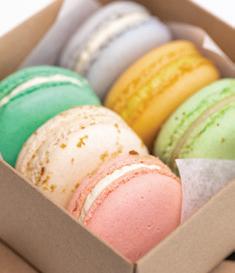




• 2 cups Rice (rice should not be sticky)
• 2 cups grated jaggery
• 2 tsp ghee + for deep frying
• 2 tbsp milk
• 2 tbsp poppy seeds

• Wash the rice twice. Soak it well in water for five days. Change the water daily.
• On the sixth day, drain the water and spread soaked rice grains on a cloth. Let them dry out.
• Grind to a dry, fine powder. Sieve the powder through a fine mesh.

By Chef Ranveer Brar @ranveer.brar
• Combine powdered rice, jaggery, ghee and start kneading. Add milk to make a pliable dough. It should be semi-soft.
• Divide into 12-14 equal portions and make balls out of it.
• Sprinkle poppy seeds and place a dough ball over it. Start rolling over it and roll like a thick puri.
• Heat ghee in a deep vessel. Deep fry the prepared anarsa in the ghee till golden brown.
• Drain the excess ghee and serve.

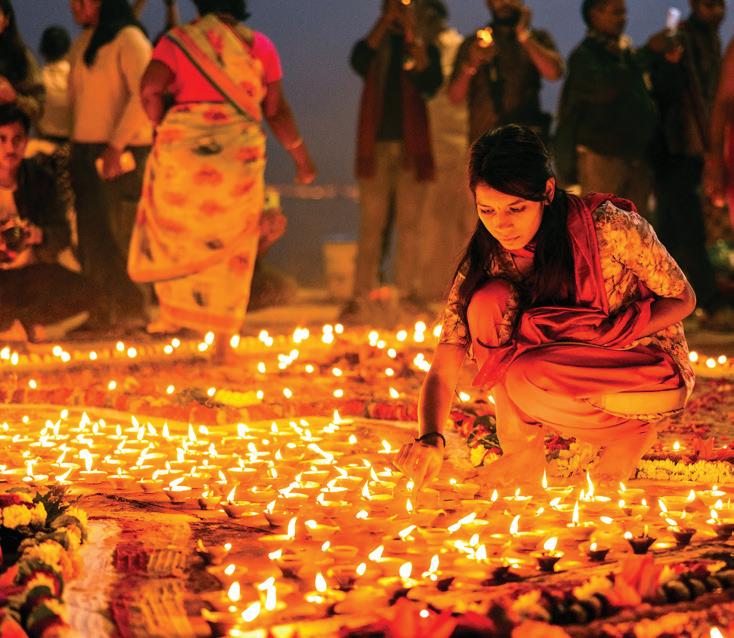
By Shweta Kulkarni
Deeply embedded in Indian tradition, Diwali is most popularly associated with Lord Rama’s return to Ayodhya after 14 years of exile and his victory over the demon king Ravana. However, beyond this legendary narrative, the true essence of Diwali embodies the triumph of light over darkness and is celebrated with distinct customs and flair across the country.
So, if you want to experience this beloved festival in all its grandeur, here’s a list of the top destinations where Diwali festivities are not only dazzling but unique, too.








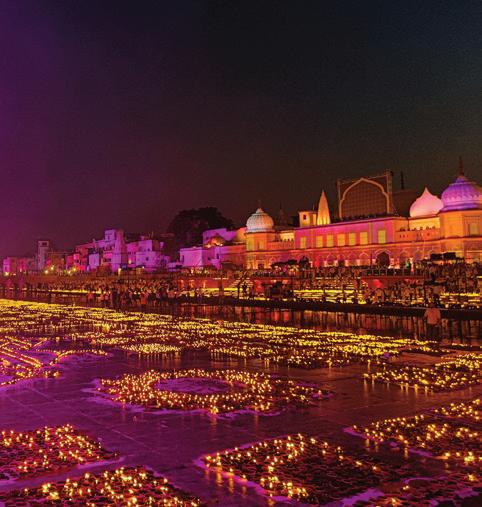
Diwali in Ayodhya is not just a festival, it is a divine spectacle steeped in devotion and ancient legend. A visit to Ayodhya during this festive time is not only a visual feast but also considered a one-ofa-kind spiritual experience. The entire city is bathed in a warm glow as millions of diyas light up the town. At the heart of this celebration is the Sarayu River, gleaming brightly with thousands of floating lamps, and the grand evening aarti performed on its riverbanks adds unmatched spiritual energy. Visitors can participate in the diya-lighting rituals, listen to Ramayana recitals by the river, and enjoy the traditional Ram Leela performances. Don’t forget to indulge in mouthwatering festive food like piping hot

jalebis, bati chokha, bedmi pooris, kachoris, laddus, and barfis from the bustling street stalls. With the newly inaugurated Ram Mandir, this year’s Diwali celebrations in Ayodhya are expected to be grander than usual, so book your trip well in advance.
Experiencing Diwali at the spiritual center of Sikhism feels nothing short of magical. What makes Diwali truly special in Amritsar is the coinciding celebration of Bandi Chhor Diwas. A significant day in Sikh history marks the release of Guru Hargobind and 52 Hindu kings from imprisonment in Gwalior Fort. The celebration here thus blends the spiritual essence of both the festivals breathtakingly. The iconic Golden Temple is illuminated with lamps and strings of lights, their reflections dancing on the waters of the Amrit Sarovar, which is mesmerizing to watch. The gurudwara echoes with kirtans, and the reading of the Akhand Path adds to the divine atmosphere. Furthermore,

the Nagar Kirtan processions and the display of Gatka (Sikh martial arts) bring the streets to life. And while the traditional and cultural celebration is the main draw, don’t forget to treat your tastebuds to the best of Punjabi cuisine— from the beloved Amritsari kulcha and chole to sarson da saag with makki di roti, creamy dal makhani , and refreshing lassi —Diwali celebration in Amritsar isn’t just a spiritually enriching experience, it is a rich culinary adventure as well.
Think Goa is all about sunkissed beaches and non-stop parties? Well, think again. Goa is a fascinating mix of tradition and modernity, and its Diwali celebrations bring a distinctive coastal charm, with Naraka Chaturdashi stealing the spotlight. The tradition, known as Narakasura Vadh, involves burning effigies of Narakasura, symbolizing the triumph of good over evil. Across Goa, competitions are held for the best effigy, followed by spectacular fireworks displays. For the best experience, head to Panaji, Mapusa, or Margao, where massive effigies are marched through the


streets, often accompanied by traditional music and dance.
The usually laid-back streets of Goa come alive with a festive glow during Diwali. So, whether you are lighting diyas by the beach, watching fireworks, or mingling with locals during the festive procession, celebrating Diwali in Goa is an unforgettable experience.
For a Diwali experience that is spiritual and truly immersive, head to Varanasi. The ghats along the Ganges turn into a sea of light, with earthen diyas casting their glow on the holy river. While the Ganga Aarti on the ghats is a sight











■ PERSONAL INJURY / ICBC CLAIMS
PERSONAL INJURY / ICBC CLAIMS ■ RESIDENTIAL / COMMERCIAL REALESTATE
■ RESIDENTIAL / COMMERCIAL REALESTATE
■ CORPORATE / COMMERCIAL LAW
■ CORPORATE / COMMERCIAL LAW
■ TRUST & SHAREHOLDER'S AGREEMENTS
■ TRUST & SHAREHOLDER'S AGREEMENTS
■ BUYING / SELLING BUSINESSES
■ BUYING / SELLING BUSINESSES
■ PERSONAL INJURY / ICBC CLAIMS ■ RESIDENTIAL / COMMERCIAL REALESTATE ■ CORPORATE / COMMERCIAL LAW ■ TRUST & SHAREHOLDER'S AGREEMENTS


■ PROPERTY SUB-DIVISIONS ■ WILLS & ESTATES ■ CONTRACT DISPUTES ■ COMMERCIAL LITIGATION ■ BUILDER'S LIENS ■ COLLECTIONS ■ GENERAL LITIGATION
■ PROPERTY SUB-DIVISIONS ■
■ BUYING / SELLING BUSINESSES ■ PROPERTY SUB-DIVISIONS ■


& ESTATES ■ CONTRACT DISPUTES ■ COMMERCIAL LITIGATION BUILDER'S LIENS
DISPUTES
LITIGATION
LIENS
FAMILY LAW

LITIGATION










to behold, during Diwali it becomes even more fascinating. However, the real festive fervor unfolds during Dev Deepawali, which is celebrated on Kartik Poornima. The city sparkles with light, and the air is abuzz with devotional energy. The streets are alive with colorful rangolis, the aroma of mouthwatering delicacies, and an unmatched festive cheer. The best way to experience all the grandeur of the illuminated ghats is to take a boat ride on the Ganges—a memory sure to stay forever.
Kolkata, too, boasts a radiant celebration to mark the victory of good over evil; however,
unlike others, the bongs of West Bengal celebrate the fearless Goddess Kali and her triumph over the demon Raktabija. The streets are illuminated with extravagant light displays, and the hypnotic beats of the dhak (traditional drum) can be heard in every corner. One of the best ways to experience Kali Puja in Kolkata is to visit various pandals showcasing Kolkata’s artistic brilliance. Artisans work all year round to create an immersive experience at pandals dedicated to Maa Kali. Some of the most awe-inspiring decorations can be witnessed at Kalighat Kali Temple, Chetla Agrani Club, and Dakshineswar Kali Temple. Celebrations in Kolkata are incomplete
without sweets, so don’t miss out on delectable sweets like sandesh and rosogolla. So, if you want a Diwali experience that blends art, devotion, and delicious food, Kolkata needs to be on your list.
No matter where you choose to celebrate Diwali, each destination offers its unique take on this beloved festival. From spiritual traditions to vibrant celebrations, Diwali truly brings India’s diversity to life.



To us, every sofa, chair and bed we create is a work of art. For over 30 years, we have mastered our craft of designing and manufacturing custom, upholstered furniture.

By Natasha D'souza
It’s time for the showstopper of all festivals, and while the lights and sweets can be your sweet spot, let’s not brush aside the real sparkle—you! This year, why not ditch the usual routine and embrace the ancient wisdom of Ayurveda? It’s time to change the gears of your beauty game with some timeless and natural rituals that not only pamper you but also honor our heritage.
Ayurveda, which means ‘the science of life,’ is all about finding that perfect balance in your body and mind. It's about feeling good inside out. This Diwali, let’s tap into the power of nature and celebrate our uniqueness while making holiday care a priority. Illuminate with these earth-

loving Ayurvedic rituals that will recast your inner ‘best’ and make you feel anew.
• Herbal Face Masks: Forget the harsh chemicals and say hello to turmeric, neem, and sandalwood! These aren’t just your grandma’s remedies; they’re your skin’s new best friends. Think glowing skin, fewer breakouts, and an overall radiant vibe!
• Oils Are Your BFF: Want that dewy, fresh look? A few drops of Kumkumadi





oil or rose oil can work wonders. They hydrate and brighten your skin, making you selfie-ready without the ring lights.
• Exfoliation is an Obligation: Mix sugar and honey for a super gentle scrub to leave your skin feeling soft and smooth. It’s like giving your face a mini vacation!
• Amla Oil Magic: If you want strong, shiny hair that’s flip-worthy, warm up some amla oil and massage it into your scalp. Your hair will thank you!
• Bhringraj Bliss: Create a DIY hair mask with Bhringraj powder. This ancient herb is a total gamechanger for boosting hair health and fighting greys.
• Fenugreek Power: Soak fenugreek seeds overnight, blend them into a paste, and slather it on your hair for a nourishing treatment. You’ll be rocking those luscious locks in no time!
• Abhyanga: Treat yourself to a warm sesame oil massage—seriously, it’s


as good as it sounds! This practice boosts circulation and leaves your skin feeling pampered.
• Detox Bath Vibes: Whip up a detoxifying bath with herbs like neem and lavender. It’s not just a bath; it’s a whole experience that cleanses your body and soothes your mind.
• Oats for the Win: Mix ground oats with yogurt for a quick exfoliating scrub. It’ll polish your skin and leave you feeling fabulous.


Not without adaptogens! These magical herbs help your body adapt to stress. Think of them as your natural shield against the holiday chaos…
• Ashwagandha: This powerhouse helps alleviate anxiety and boosts skin elasticity. Mix it into your smoothies or take it as a supplement to feel the glow inside out.
• Holy Basil (Tulsi): Not just a pretty herb, Tulsi is a detoxifier that can elevate your skin game. Brew it as tea or add it to your dishes for an instant health boost.
• Licorice Love: Licorice root isn’t just for candy; it’s amazing for an even skin tone and a bright complexion. You can find it in skincare products or use it as a powder in DIY masks.
Remember, Diwali isn’t just about looking good; it’s about feeling good, too. Incorporate mindfulness practices like meditation or yoga into your routine. After all, the glow needs to stem from deep within! It’ll help

you stay centered and ready to embrace all the festivities with joy, excitement, and fulfillment.
This Diwali, we’re not just celebrating; we’re glowing! By adding these ancient Ayurvedic rituals to your beauty regime, you’ll boost your outer beauty and vibe with your inner self.
As you light your diyas and dive into the festivities, know that you can only reflect what you feel! Your bean comes from your beingfrom feeling good and living your best life. This Diwali, let self-love and self-care be your biggest flex!
So, who’s ready to slay the festival of lights with their dazzling selves? We’re down!
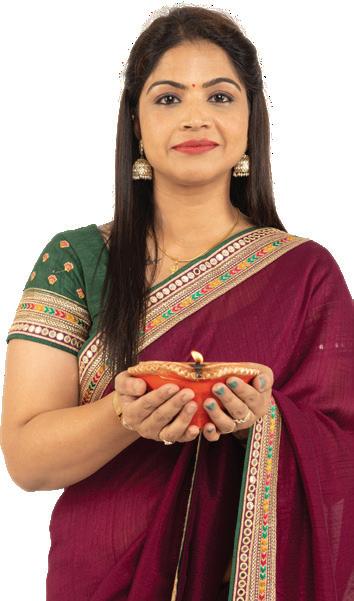


By Mrinalini Sundar
What’s Diwali without showing off your new festive outfits and capturing countless pictures? We all love indulging in trending festive wear during this time. But how often have you considered using the festive season to showcase the rich heritage of Indian textiles? A country like India is renowned for its distinctive fabrics and traditional weaving techniques across various states. Wearing these textiles during the illuminating festival of Diwali not only adds shimmer and style but also honors the craftsmanship of the artisans. Here, we explore how these vibrant textiles from different Indian regions can be incorporated into Diwali celebrations while highlighting efforts to revive these traditions.
When you arrive in Varanasi, you can’t miss the beauty of Banarasi silk. Renowned for its luxurious texture and intricate designs, this fabric is synonymous with opulence. Woven with silver and gold zari threads, it creates stunning patterns often inspired by Mughal art, nature, and religious motifs. Banarasi sarees and lehengas are popular choices during weddings and festivals, making them perfect for Diwali celebrations.
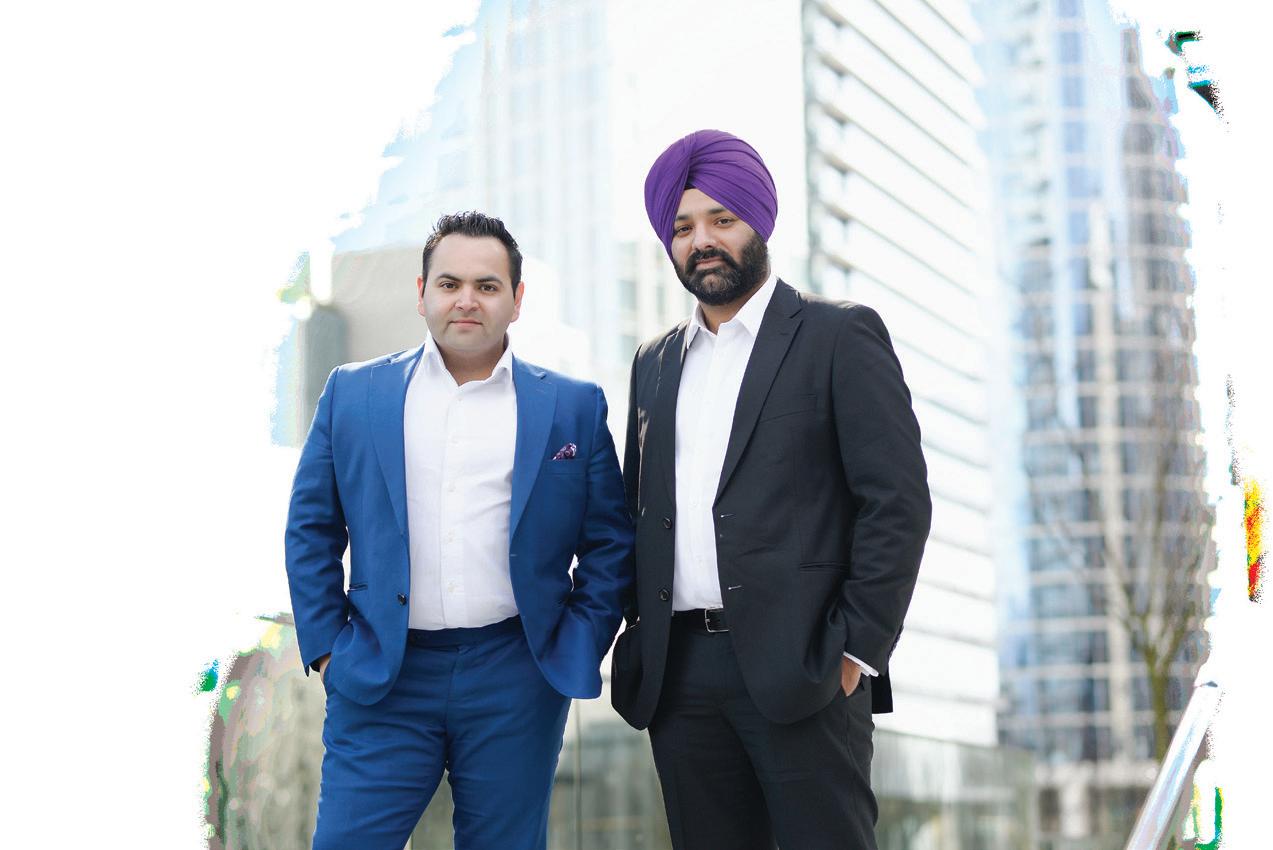



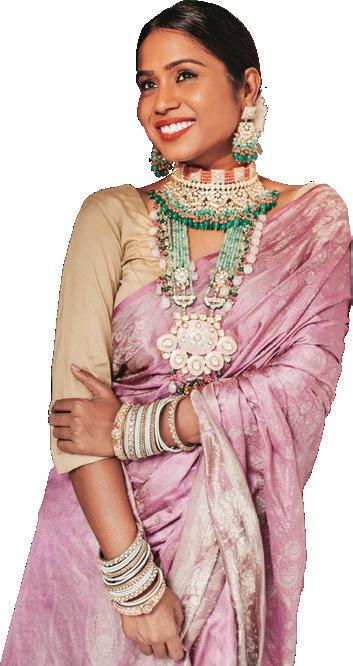
Designers like Sabyasachi Mukherjee and brands like Raw Mango have embraced Banarasi silk, bringing it to the forefront of contemporary fashion. For Diwali, consider draping yourself in a Banarasi saree or using Banarasi silk dupattas to add festive shimmer. These pieces are timeless and can be worn for any occasion. To add a Banarasi touch to your home decor, use the fabric for cushion covers to infuse a regal element.
Originating from the Chanderi town in Madhya Pradesh, Chanderi fabric is known for its sheer texture and lightweight feel. Traditionally made from a blend of silk and cotton, Chanderi textiles feature motifs like peacocks, lotuses, and geometric patterns, often woven with zari. Their elegance and comfort make them ideal choices for festive occasions like Diwali. Chanderi has seen a resurgence thanks to designers like Sanjay Garg and the Chanderiyaan project, bringing the fabric to global markets. For Diwali, Chanderi sarees and dupattas offer a sophisticated yet understated option. Pair




sarees with simple blouses and dramatic jewelry to stand out. Chanderi curtains or tablecloths can also lend a festive charm to your home.
Anyone who loves sarees likely owns a Kanjeevaram silk saree. Nothing exudes grandeur quite like Kanjeevaram silk, which comes from Kanchipuram in Tamil Nadu. Known for its durability, vibrant colors, and intricate motifs, this fabric is worn during both weddings and festive seasons. While artisans in Kanchipuram continue to craft these masterpieces using traditional looms, designers like Gaurang Shah help modernize Kanjeevaram’s appeal while preserving its heritage.


For Diwali, opt for a lighter Kanjeevaram saree in pastel tones to make a statement.
Patola, a double ikat weaving technique from Gujarat, is famous for its intricate and reversible designs. Its vibrant colors and geometric patterns make it a striking choice for festive wear. During the festive season, a Patola saree or scarf can elevate your attire.




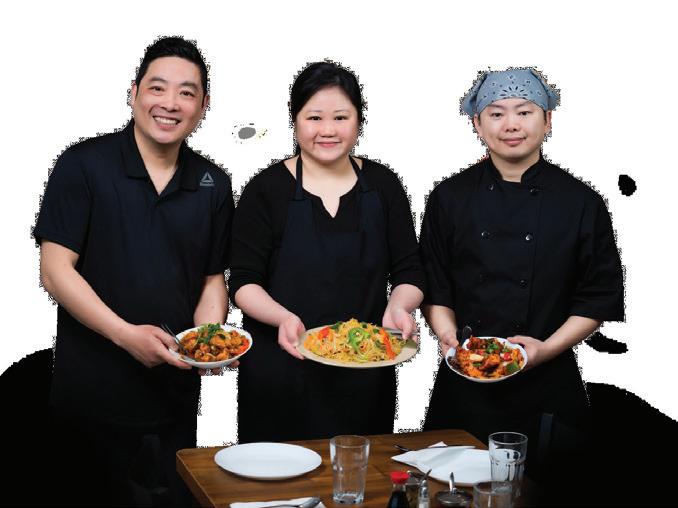
While artisans in Patan continue to practice this ancient craft, designers like Anuradha Vakil play a crucial role in bringing Patola into contemporary fashion. Patola sarees and dupattas are not only eyecatching but also symbolize Gujarat's rich textile heritage. Give your Patola look a modern twist to make it fab during Diwali!
Phulkari, meaning ‘flower work,’ is a vibrant embroidery tradition from Punjab. Traditionally, Phulkari was used to decorate shawls, dupattas, and veils, featuring intricate floral motifs stitched with silk threads on handwoven khaddar fabric. Phulkari's bright colors and elaborate designs make it a perfect textile to showcase during the festive season.
In recent years, designers like Ritu Kumar have helped revive Phulkari, bringing it into mainstream fashion. Artisans, especially women in rural Punjab, continue to keep this tradition alive, making each piece a work of art. For this festive season, incorporate


Phulkari shawls and dupattas into your simple yet elegant kurtas and suits.
Bomkai, also known as Sonepuri, is a traditional handloom fabric from Odisha, recognized for its unique weaving technique and intricate borders. Bomkai sarees often feature elaborate motifs inspired by tribal art and temple carvings, making them rich cultural expressions. A Bomkai saree is a perfect choice for Diwali, especially for those looking to make a cultural statement.
Designers and artisans
in Odisha are working to keep this tradition alive, with many using Bomkai fabrics for both traditional and contemporary garments.
While Diwali is a time of celebration, it’s also an opportunity to reflect on the rich cultural heritage of India’s textile traditions. By incorporating regional fabrics like Banarasi silk, Chanderi, or Kanjeevaram into your festive looks or home decor, you not only add a unique festive flair but also support the artisans and weavers who have preserved these traditions for centuries.










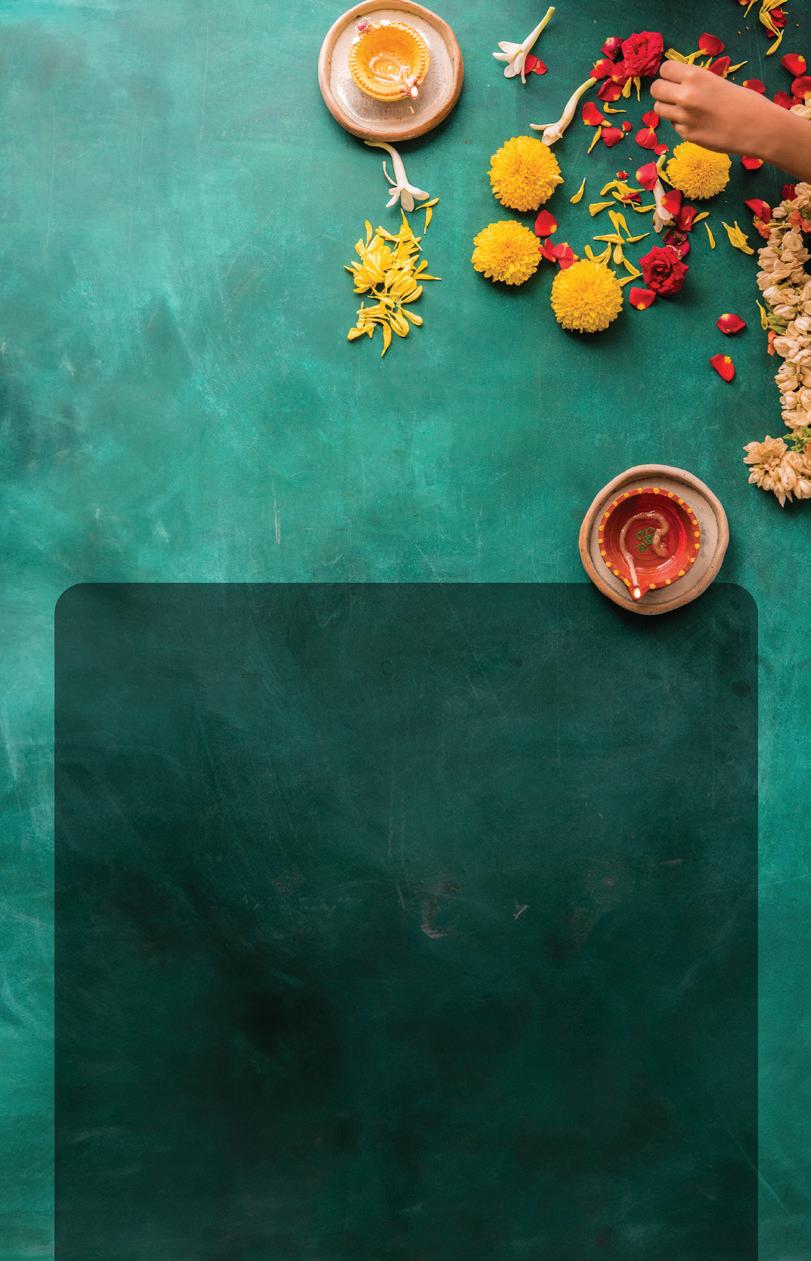
By Natasha D'souza
With responsible living emerging as a moral compass, it is safe to say that bright traditions need cleaner transitions. This year, let’s redefine Diwali—less about over-the-top extravagance and more about mindful celebration. Gone are the days of gaudy plastic decor, piles of discarded wrapping paper, and fireworks that cloud the sky. Diwali 2024 is all about staying true to the festive spirit while giving our planet a reason to get jiggy-wiggy too! So, buckle up for a zerowaste, biodegradable Diwali—packed with creativity, sustainability, and fun ways to light up the world sans the eco-guilt.

Who says zero-waste decor has to be boring? Create Pinterest-perfect motifs using fallen leaves, dried flowers, old fabric, and newspapers. Craft elegant leaf lanterns by layering leaves with biodegradable glue onto paper molds, and use kitchen staples like turmeric, pulses, and flower petals for upcycled rangoli designs. Don’t forget to shred old newspapers into colorful garlands with vegetable-based inks or natural dyes, creating chic, eco-friendly decorations that shine through.




Let’s face it—those paraffin wax candles aren’t doing Mother Earth any favor. Instead, go the edible route with ‘eat lamps’. Gather some unsalted butter and mold it into candles. Simply insert a cotton wick, light it up, and watch your home glow in eco-friendly splendor. Not only are these charming and biodegradable, but they are a fun dining table addition, too. It’s a win-win for sustainability and flavor! If that’s too much work for you, you can give the traditional diyas a green twist by using edible ghee or oil!

Talk about gifts that are the usual pass-arounds and eventually land up in a corner; sounds familiar, right? Sure, we love shiny wrapping paper and glitzy ribbons, but let’s leave those in 2019. This Diwali, take gifting up a notch with thoughtful, waste-free surprises:
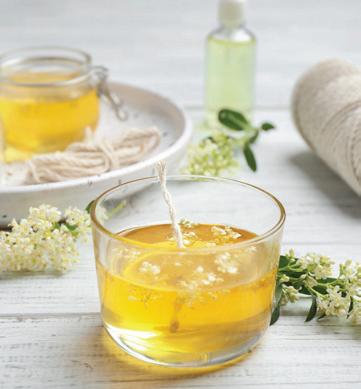
Color bombs add a vibrant flair to your celebrations without the pollution and waste that fireworks create. Go for biodegradable options that burst with colors and joy while being kind to the environment. These ecofriendly alternatives ensure that the festivities spark through without leaving a mess. Plus, they scream whimsical mood-board without taking a toll on furries and the elderly around you.
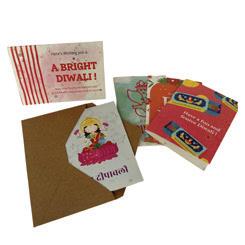
Swap traditional cards for plantable seed paper. Once read, your friends and family can plant the seed paper in their garden and watch wildflowers grow as a keepsake of your love.






How about gifting a chic bamboo toothbrush set, a jute tote, or a DIY natural soap kit? Not only are these gifts functional, but they also double up as a bonafide “I care about you and the planet” gesture.


What makes a zero-waste Diwali truly special isn’t just the festival itself—it’s the opportunity to carry that mindset into everyday life. By making small shifts during celebrations, we cultivate habits that last yearround. From using biodegradable materials to making conscious shopping choices, every little step counts.
Here’s to a crackling Diwali lit in every way— great for you, your crew, and the planet. Cheers to a “no-nonsense” celebration!
Channel your inner Japanese with furoshiki— the art of wrapping gifts in beautiful fabric. It’s reusable and stylish; you can bet it’ll be a conversation starter at your Diwali party.
Fast fashion can be a Diwali downfall, but sing a new song—through slow, sustainable fashion—this year. Rent or swap your outfits instead of buying new ones. Toronto, Vancouver, and Montreal have vibrant communities that offer designer rentals. You’ll be sparkling in high fashion without adding to your closet clutter or the planet.
If you’re feeling crafty, upcycle an old sari or dupatta into something new and fabulous! Create a modern twist on traditional wear without breaking the bank or harming the planet.







STEP 1: Cut out a 7 by 14 inch rectangle of coloured cardsheet. Make it into a cylinder shape and stick the ends together.
STEP 2: Then, for the cut-outs to be pasted on the cylinder, cut out cardsheet squares of size 4.5 inch. You will need at least 10-12 squares for the lantern.
STEP 3: Stick together the opposite corners of the square sheets, overlapping the corners. Then, leaving a gap of at least 0.35 inch from the top and bottom edges, stick the squares on the cylinder next to each other till the cylinder is completely covered.
STEP 4: For the base strips, use butter paper/tracing paper that is about 14 inch wide and 11-15 inch long, depending on how long you want the strips. Cut the strips leaving about 0.5-0.75 inch on top.
STEP 5: Stick the strips to the cylinder by applying glue to the top edge. To give the lantern a more finished look, stick a colourful or sequin strip on the top and bottom edge of the cylinder.
STEP 6: You can decorate the lantern further by adding colourful cut outs of either flowers, moons or other designs on the overlapping ends of the square.
STEP 7: Lastly, attach a string at the top to hang the lantern from.














Create your own puzzle at WordMint.com or print one of our
pre-made word searches, crosswords, and more.


This festive season, here's something kids can do to make the festival more joyful and fun.
Happy Diwali!



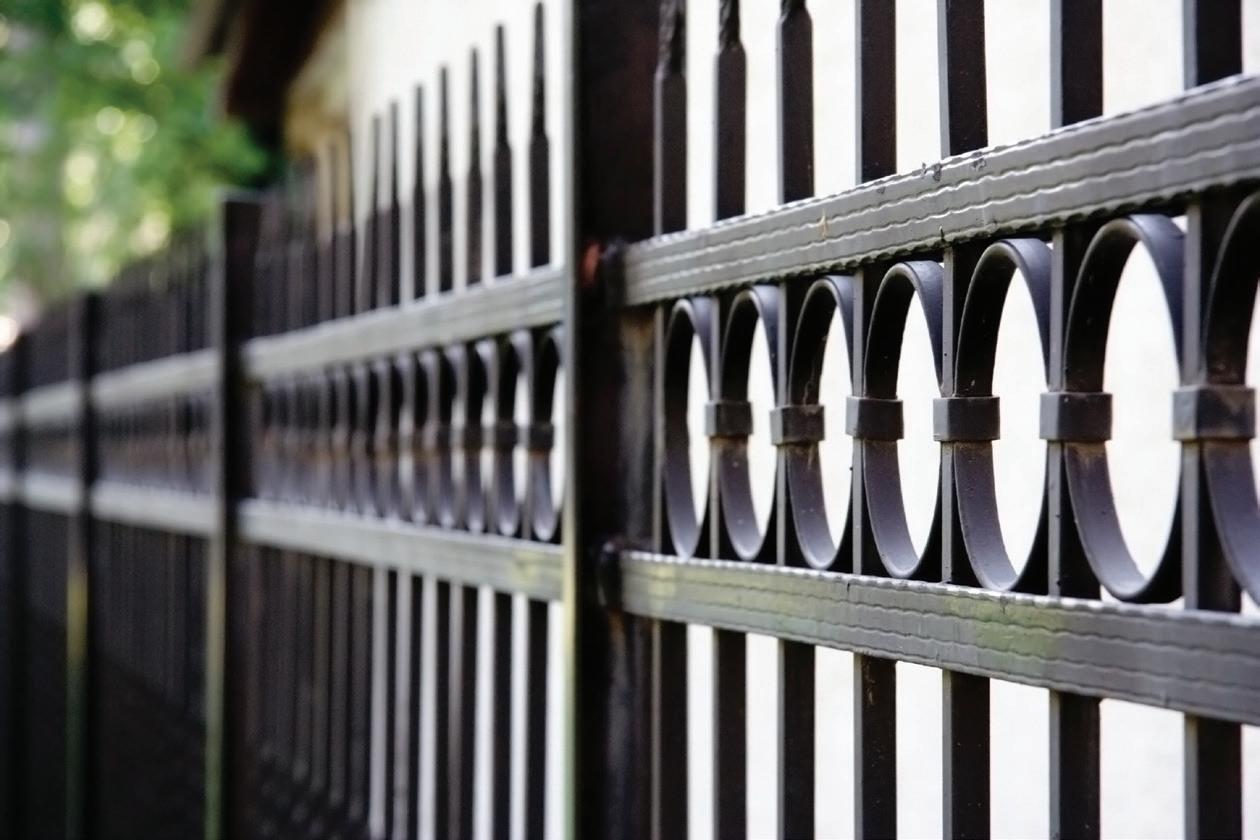







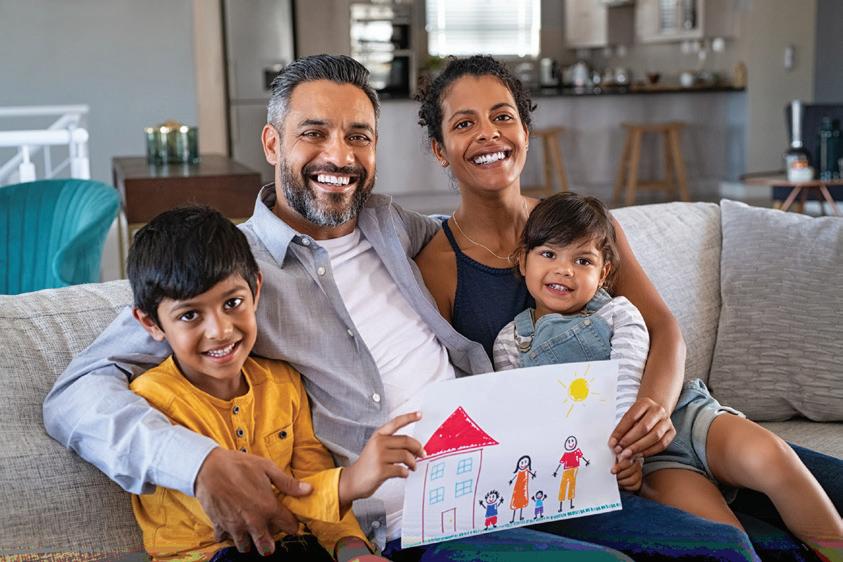


















[2] Floral decorations commonly used during Diwali
[2] Floral decorations commonly used during Diwali
[4] This festival marks the victory of good over ...
[4] This festival marks the victory of good over ...
[5] Diwali commemorates the victory of Lord Rama over this demon king
[5] Diwali commemorates the victory of Lord Rama over this demon king
[7] Five-day Diwali festival begins with this day
[8] Hindu goddess of wealth and prosperity
[7] Five-day Diwali festival begins with this day
[8] Hindu goddess of wealth and prosperity
[10] The festival celebrates Lord Rama's return to this kingdom after exile
[11] Oil lamps used to light homes and temples during Diwali
[10] The festival celebrates Lord Rama's return to this kingdom after exile
[11] Oil lamps used to light homes and temples during Diwali















[1] Symbolic patterns made on the floor during Diwali

[1] Symbolic patterns made on the floor during Diwali
[3] Another name for Diwali, meaning "row of lamps"
[3] Another name for Diwali, meaning "row of lamps"
[6] Diwali is associated with this Hindu epic that tells the story of Lord Rama
[6] Diwali is associated with this Hindu epic that tells the story of Lord Rama
[9] Traditional spherical sweet, exchanged during Diwali
[9] Traditional spherical sweet, exchanged during Diwali






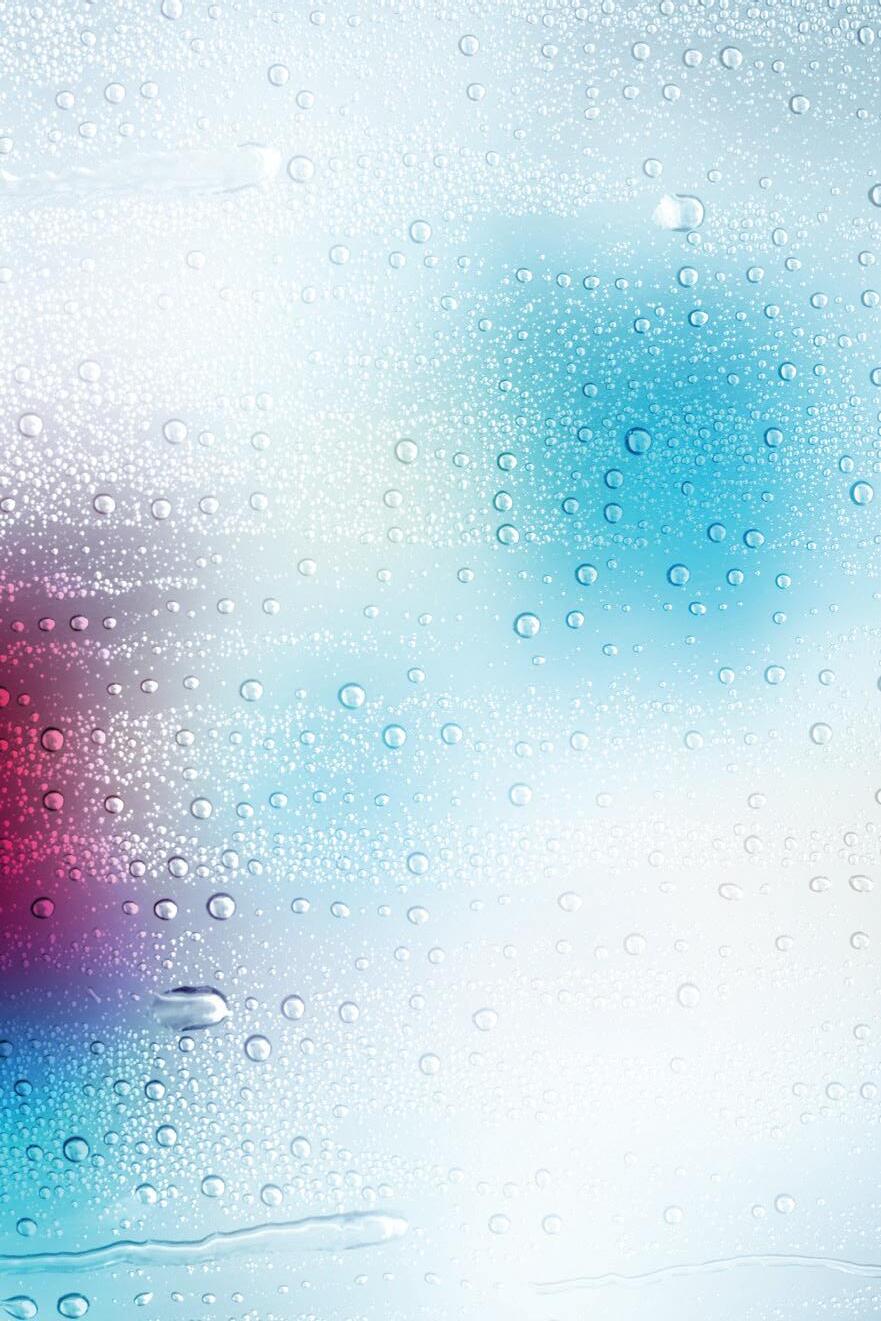




Kids age 12 and under are invited to participate in DARPAN’s Diwali contest.
You can simply take a picture of the artwork and send it to info@darpanmagazine.com OR mail it to - 340-8140, 128th St. Surrey, BC, V3W 1R1. Winners will receive a special Diwali gift.
Hurry, send your entries soon!!!




